More – MyLAB info
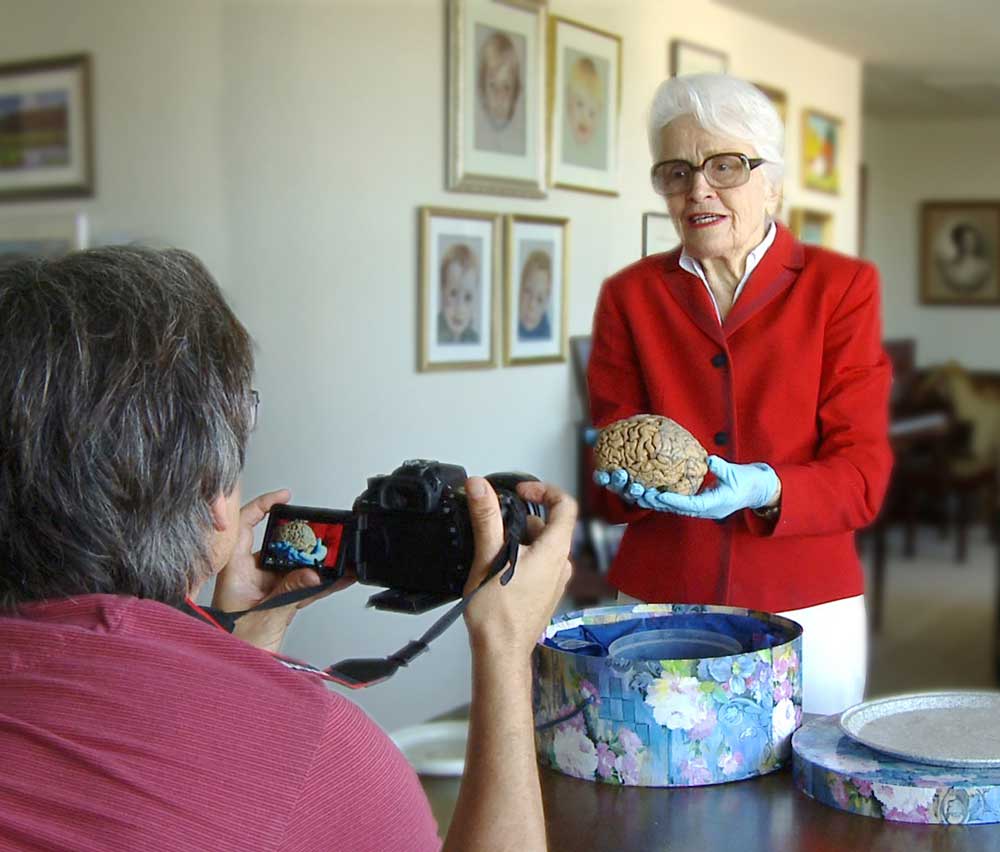
ABOUT MYLAB
MyLAB is our abbreviation for "MyLove Affair with the Brain"
about this page
... a grab bag of info. Feel free to browse ...
(migrated from previous website, not yet edited or cleaned up so please ignore the mess)
Jump to:
added elsewhere: young minds https://lunaproductions.com/young-minds/
as was:
4 quotes
- “Brilliant, buoyant, enlightening and beautiful film.” —JOYCE CAROL OATES, Author
- “A must see for every student, teacher, parent, community member, and higher education teacher prep program!” —PEGGY BROOKING, President and CEO National Board for Professional Teaching Standards
- “Marian Diamond has made major contributions to Neural Science that have stood the test of time.…. Bravo!” —ERIC R. KANDEL, Nobel Prize Winner
- “If her name isn’t yet as familiar as that of Marie Curie, it will be.” —Audience Favorite Award Commendation, Mill Valley Film Festival
For use in these fields of study:
Science
- Anatomy,
- Biology,
- Neuroscience,
- Physiology,
- Scientific Methods,
- History of Science,
- Women in STEM.
Education
- Teacher training
- Professional development,
- Childhood and Early childhood development,
- Education,
- On-line Education.
Health
- Gerontology,
- Psychiatry,
- Stroke Recovery,
- Occupational Therapy,
- Brain Health (all ages)
More
- Womens Studies
- Gender Studies,
- Community Screenings,
- Science Museums,
- Life Coaching,
- Girl Scouts,
- YMCAs
Download ready Materials - for your use
Download-ready photos, graphics, press, promo texts
Feel welcome …
OK to download and use (with credit as appropriate) any images and text from this page. It is here for YOU and for all legal promotional uses of My Love Affair with the Brain.
Download-ready, click and use TEXT:
- 1 page description
- Informational postcard at https://tinyurl.com/LoveBrain-Postcard
- Press Reviews (18 pages)
Download-ready, click and use PHOTOS & GRAPHICS:
1. Dr. Marian Diamond, photo courtesy of Luna Productions.
(landscape or square, your choice)
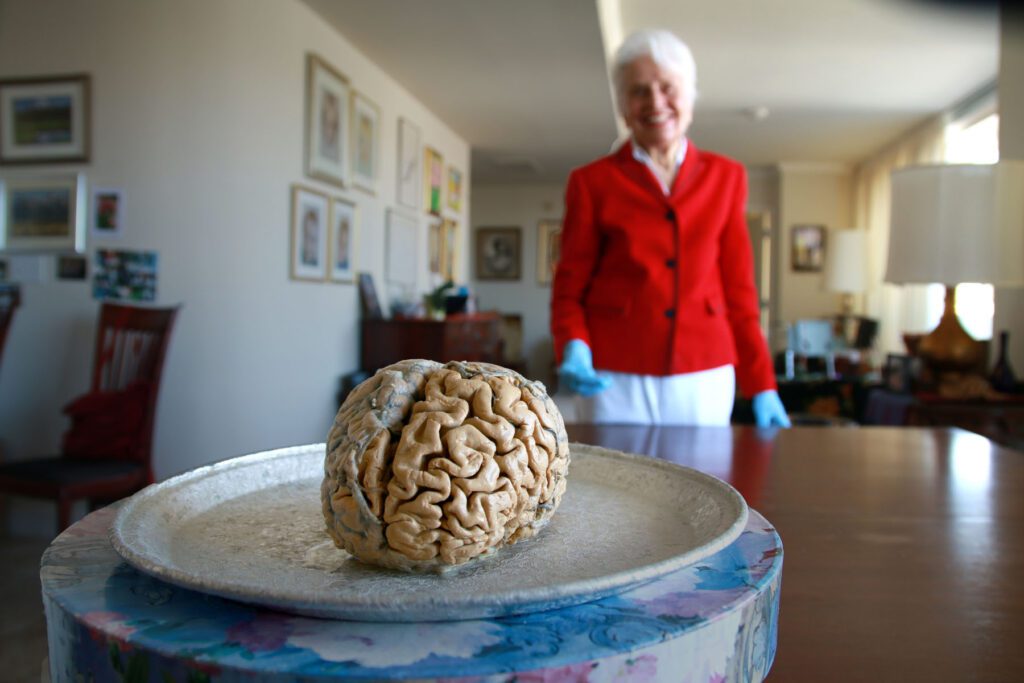
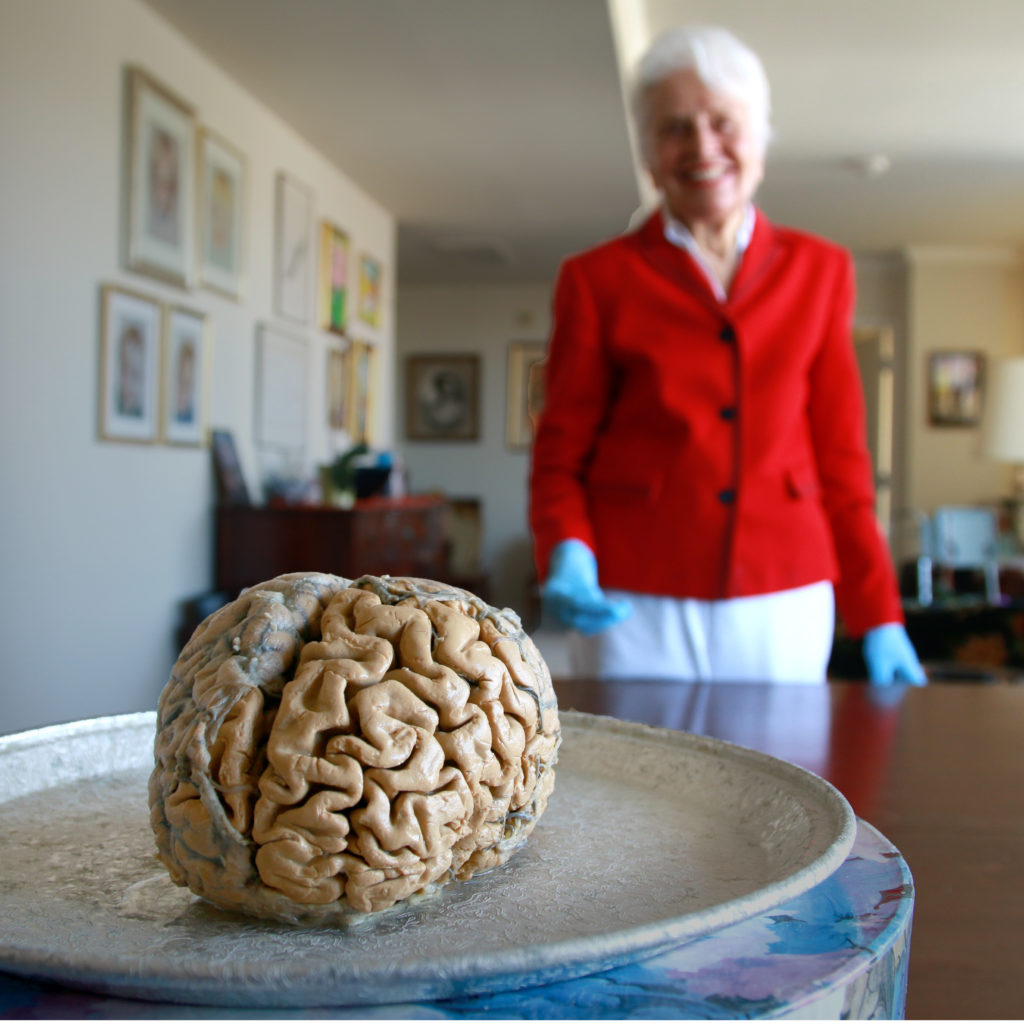
2. Dr. Marian Diamond, photo courtesy of Luna Productions.
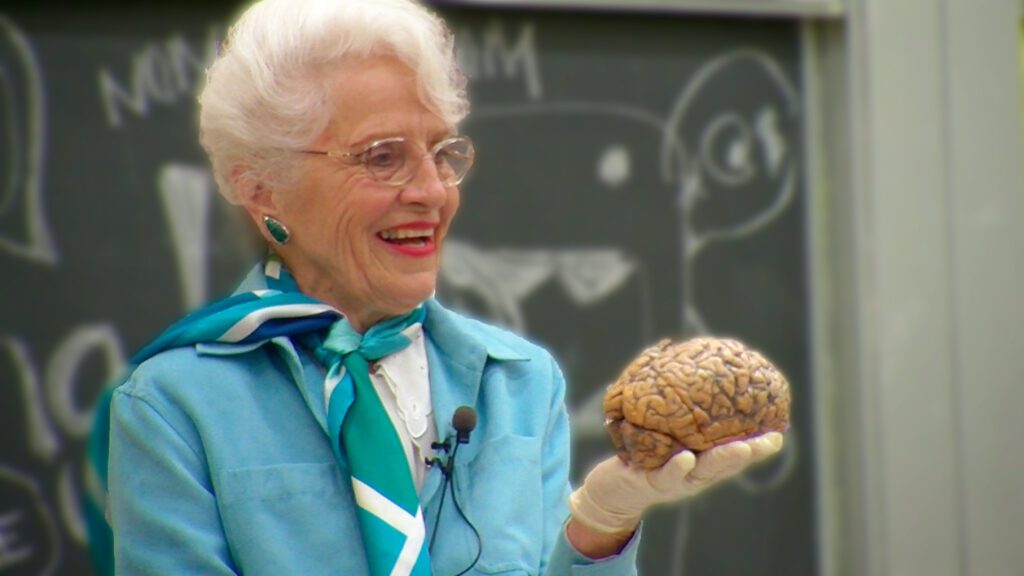
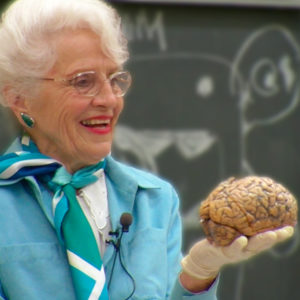
Mayim Bialik, narrator My Love Affair with the Brain, (and actress “Big Bang Theory)
She not only plays a neuroscientist on BIG BANG THEORY, but she is one in real life too, with a PhD in Neuroscience from UCLA.
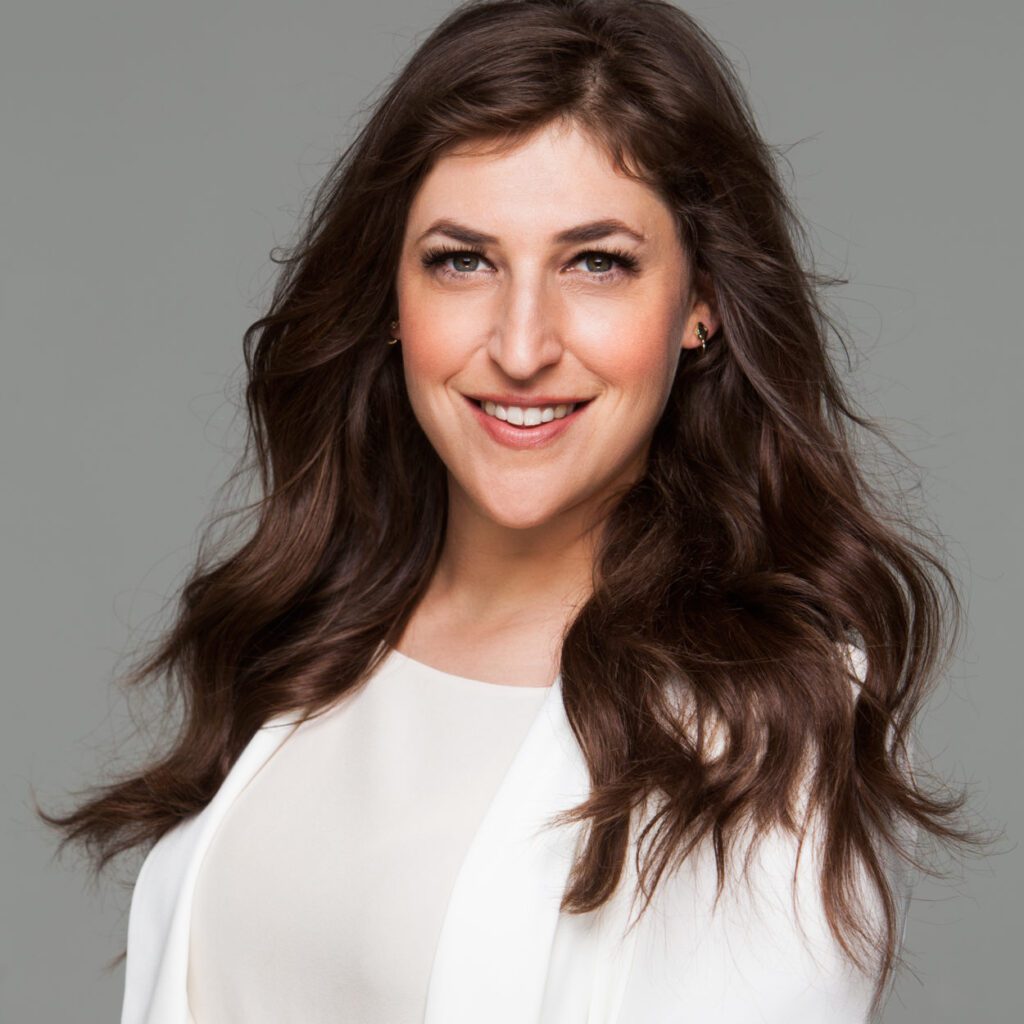
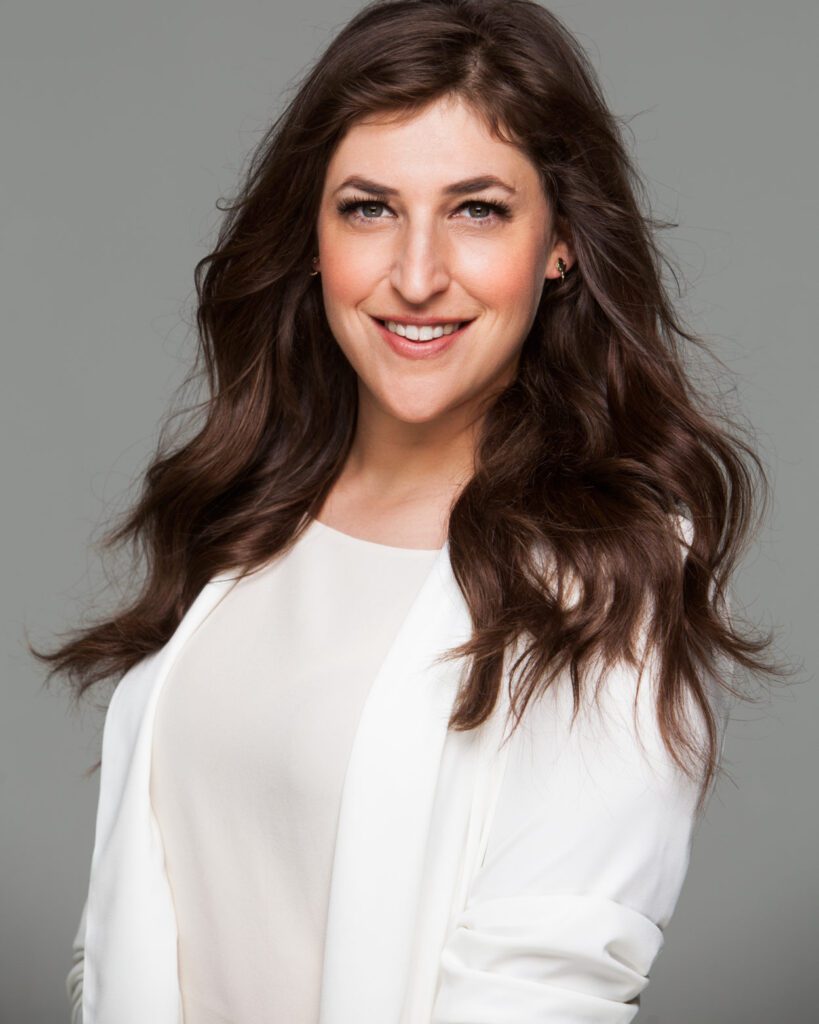
Dr Marian Diamond during filming: holding human brain and filmed by Gary Weimberg, holding hat box with Director Catherine Ryan behind camera. For documentary “My Love Affair with the Brain” Photo courtesy of Luna Productions.

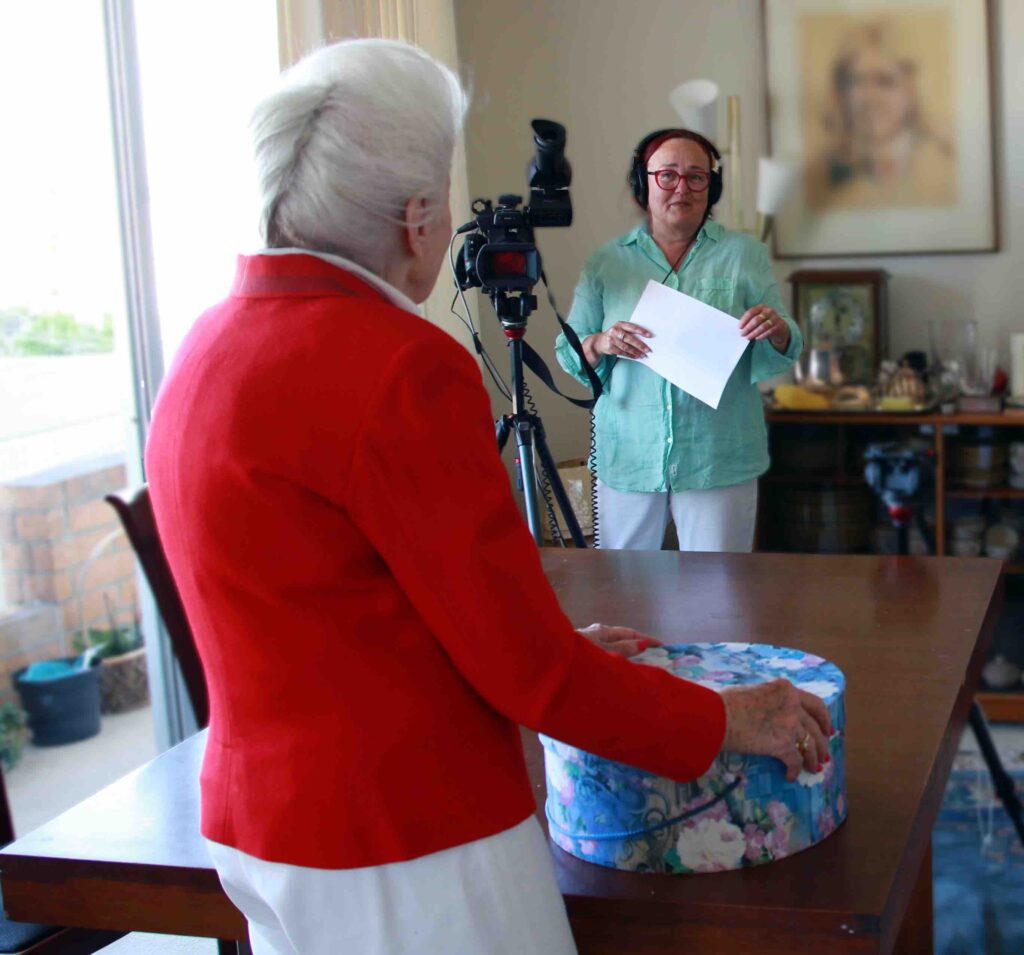
Dr. Marian Diamond, prepared for interview, for the documentary “My Love Affair with the Brain.” photo courtesy of Luna Productions.
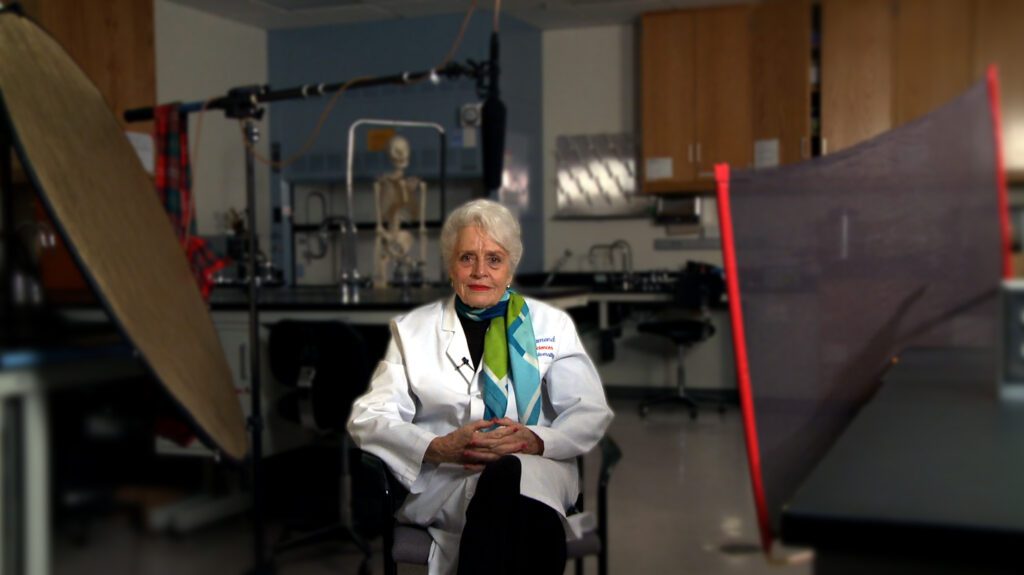
7. Dr. Marian Diamond and Indigo Prasad, age 4, who is seeing a human brain for the first time. photo courtesy of Luna Productions.
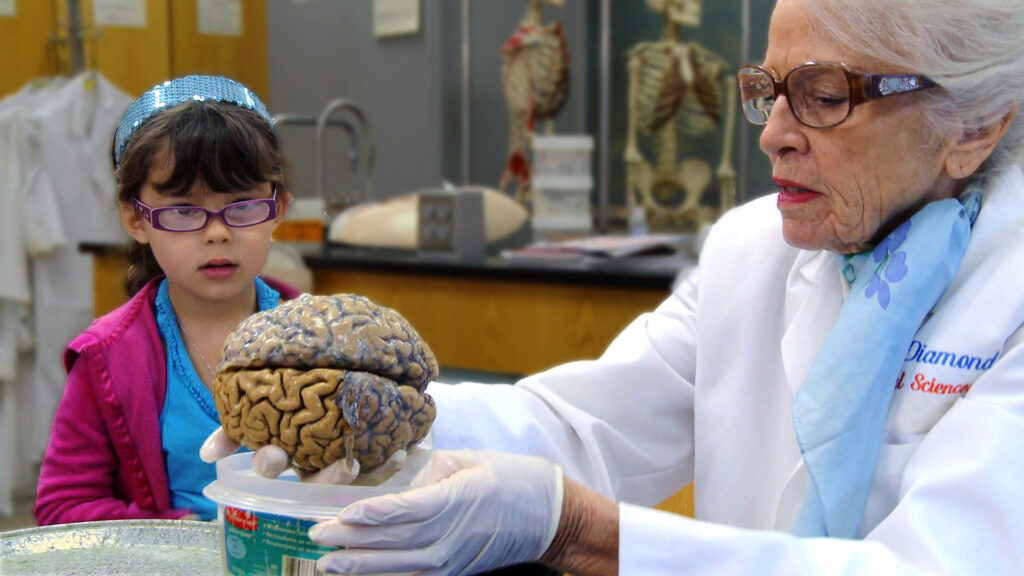
Indigo Prasad, age 4 and 14, at Q&A panel for My Love Affair with the Brain. r to l: Rick Diamond (Marian Diamonds son), Catherine Ryan (film maker), Indigo, Gary Weimberg (Film maker), Albany Film festival moderator.
Indigo recalls the moment 10 years previous – seeing a human brain for the first time while being taught by Dr. Marian Diamond. photo courtesy of Luna Productions.
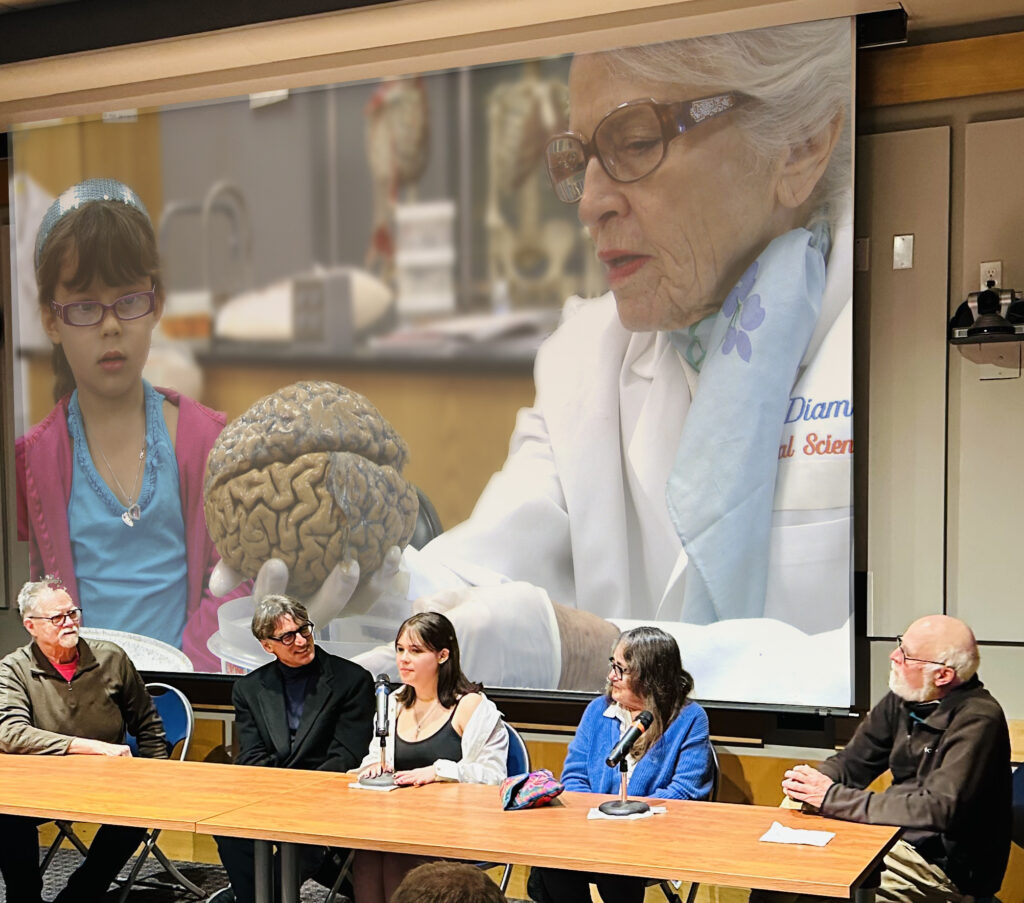
Gary Weimberg and Catherine Ryan, Producer-Directors of My Love Affair with the Brain.
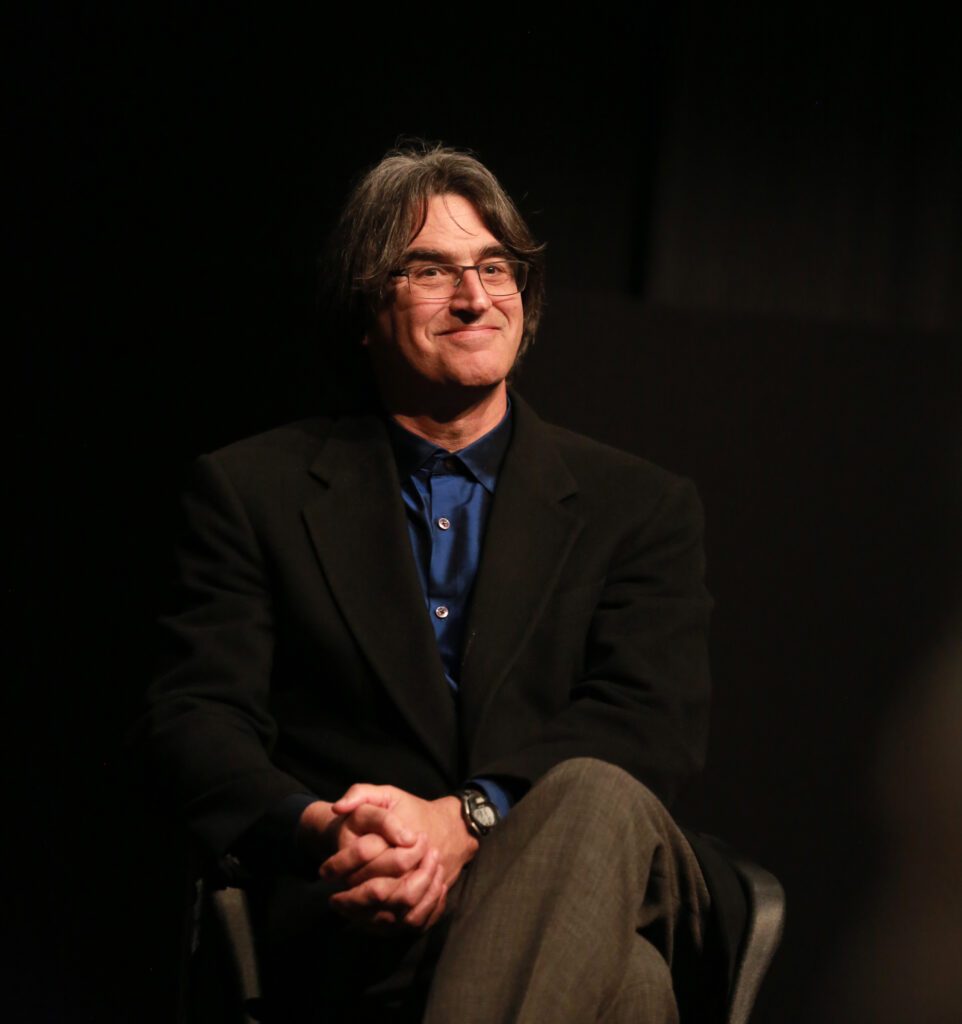
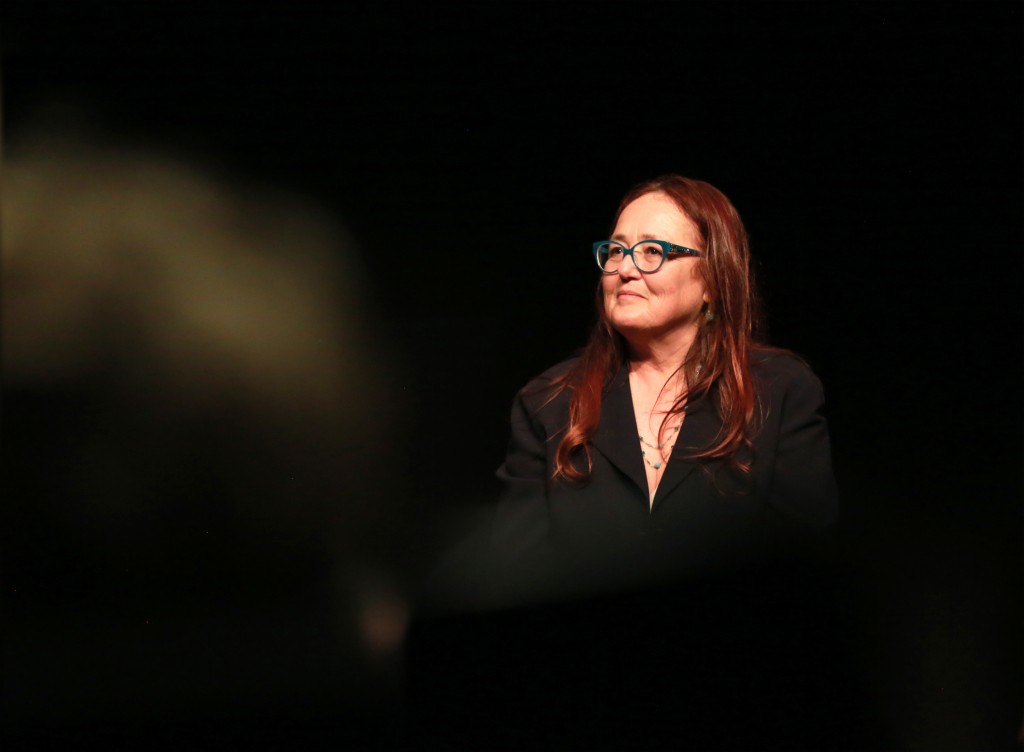
10. Promo, generic (empty red banners for you to customize w/text for your needs.)
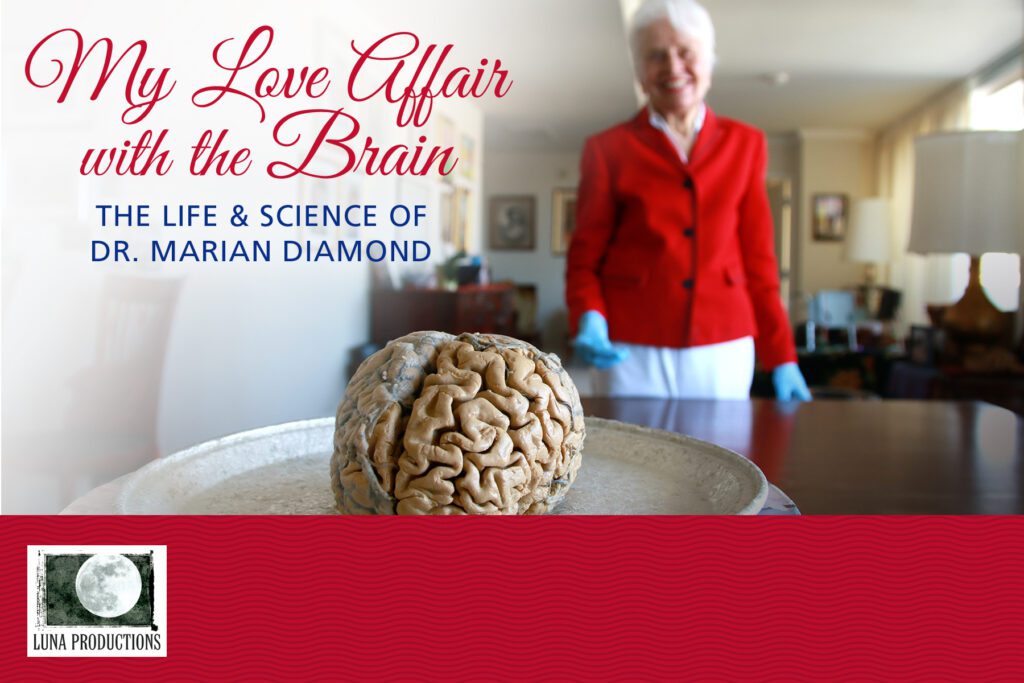
Promo – Poster
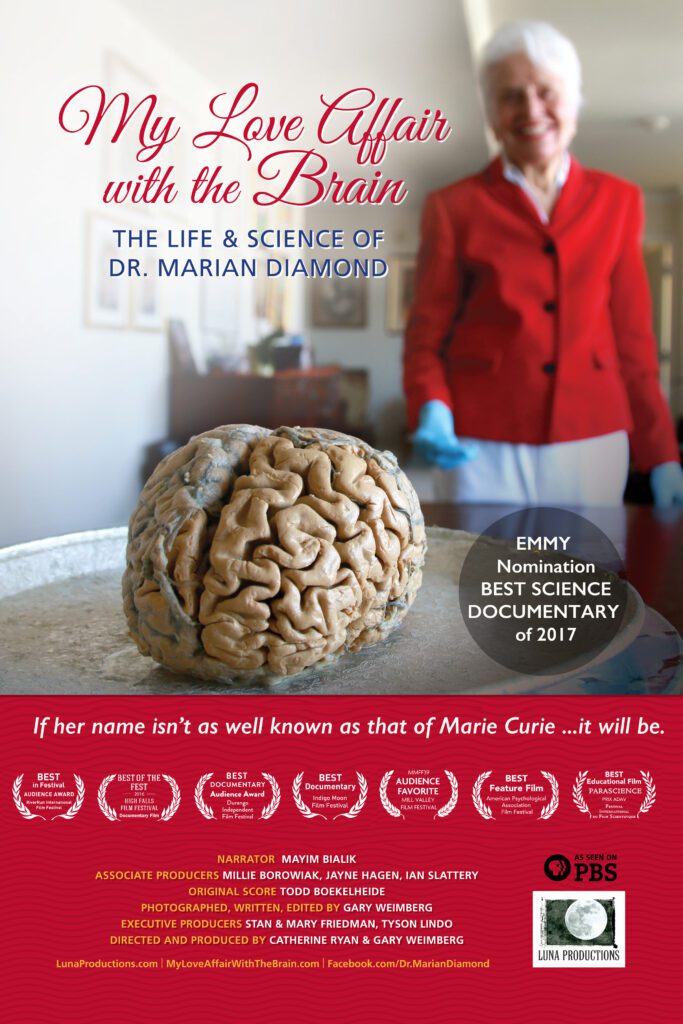
The brain
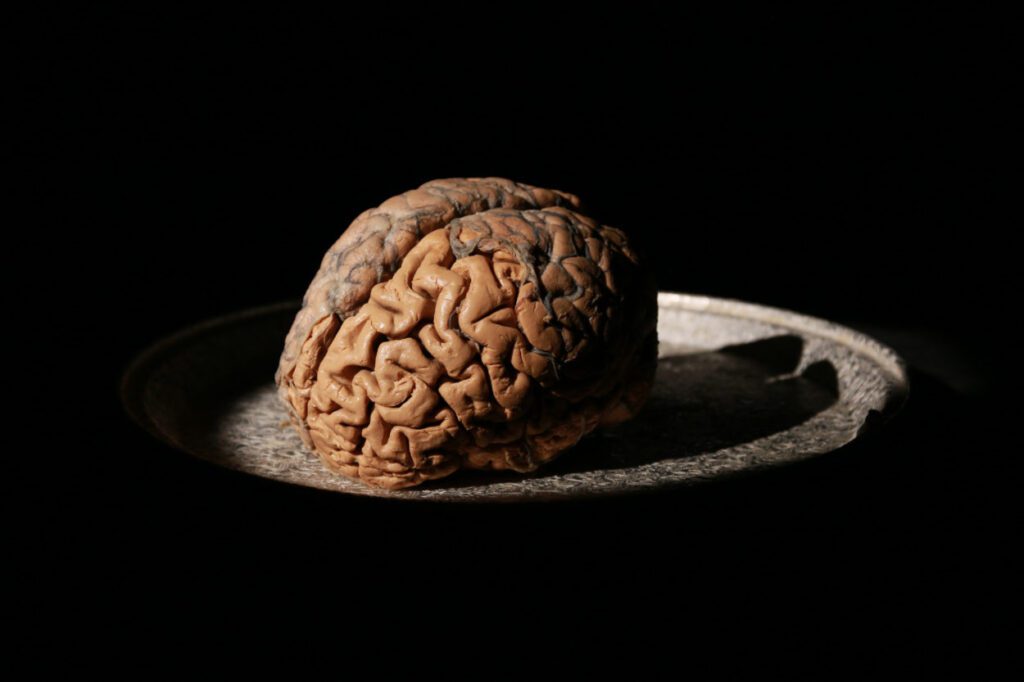
Paintings by Anne Bentley, inspired by watching the broadcast of the film.
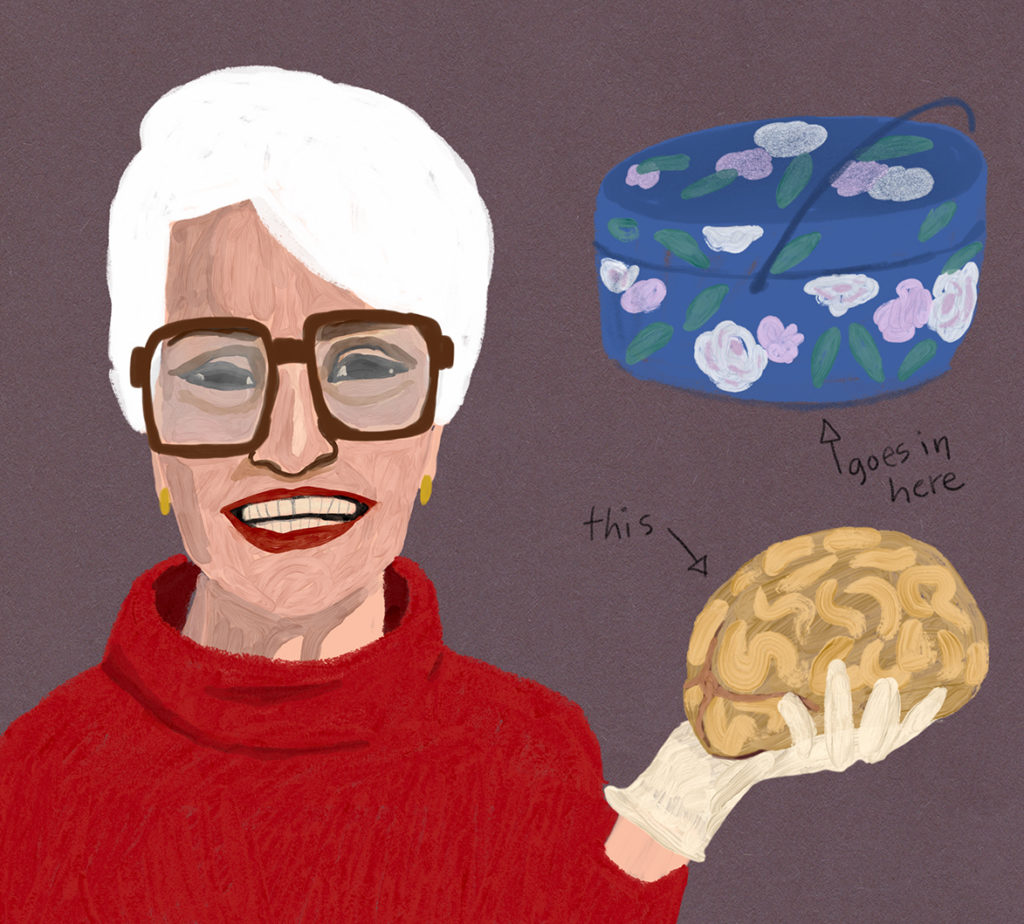
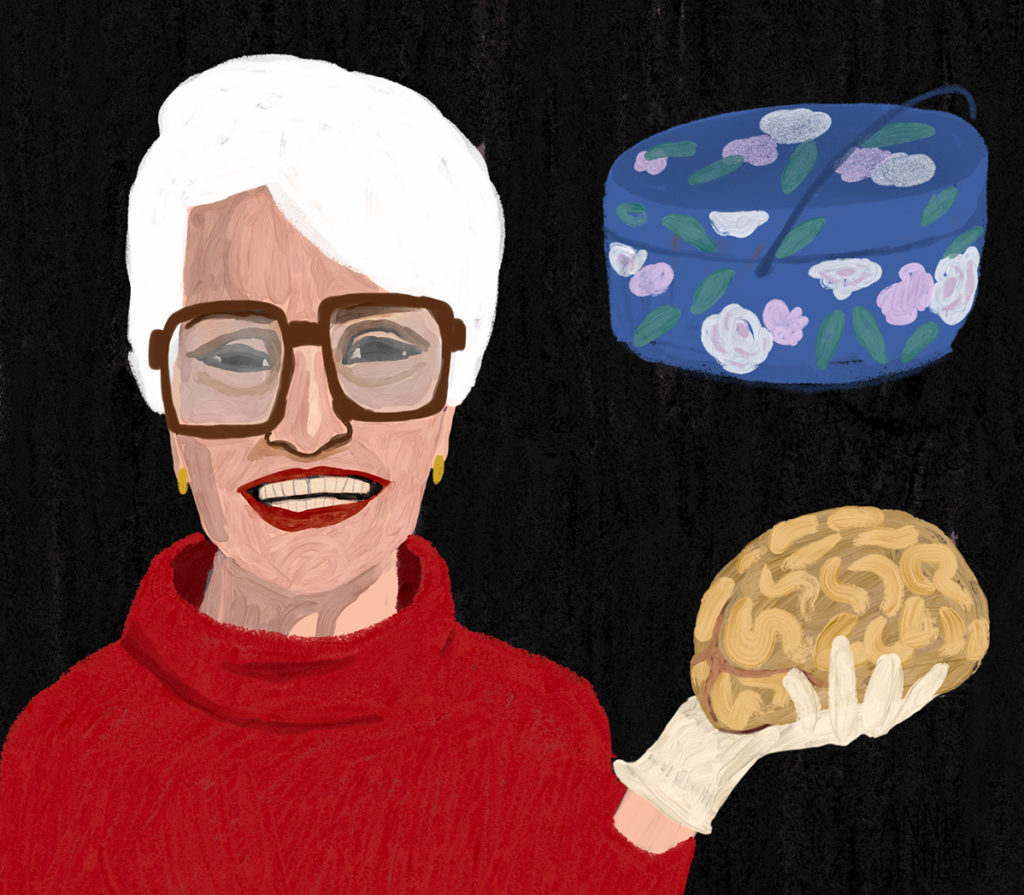
Marian Diamond, blows a kiss to the assembled UC Berkeley crowd on CAL Day, 1996
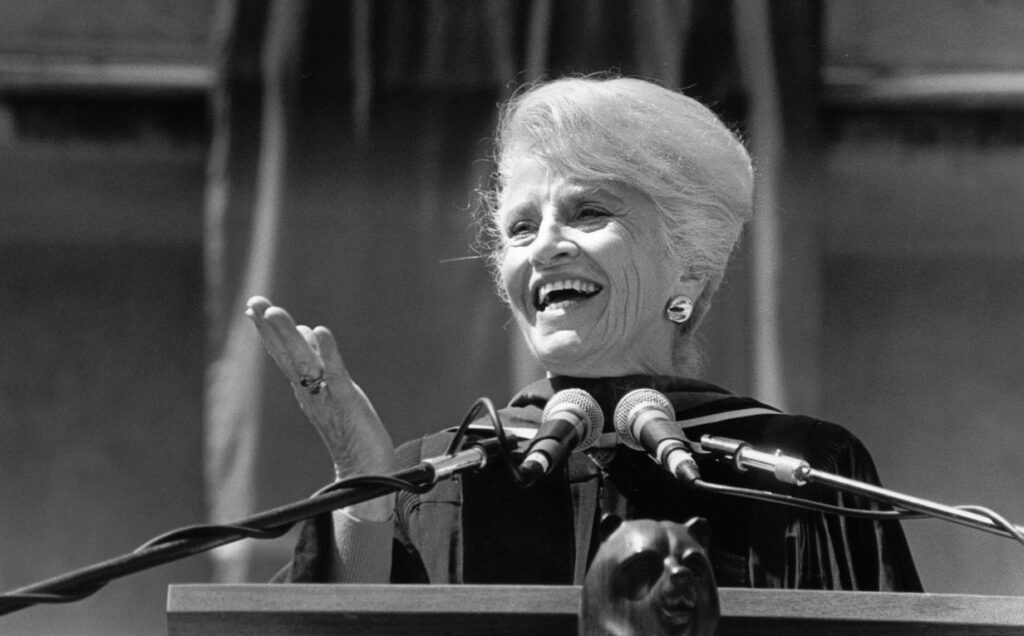
Last recording session with Marian. (L-r Marian Diamond, Arnie Scheibel, Catherine Ryan) , photo courtesy of Luna Productions:
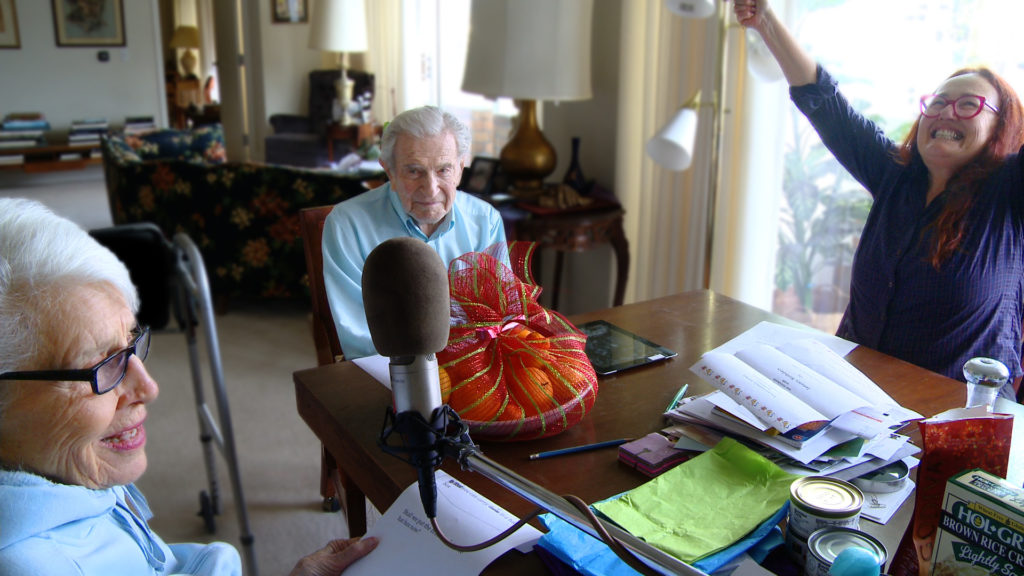
Dr. Marian Diamond in lab coat, photo courtesy of Luna Productions:
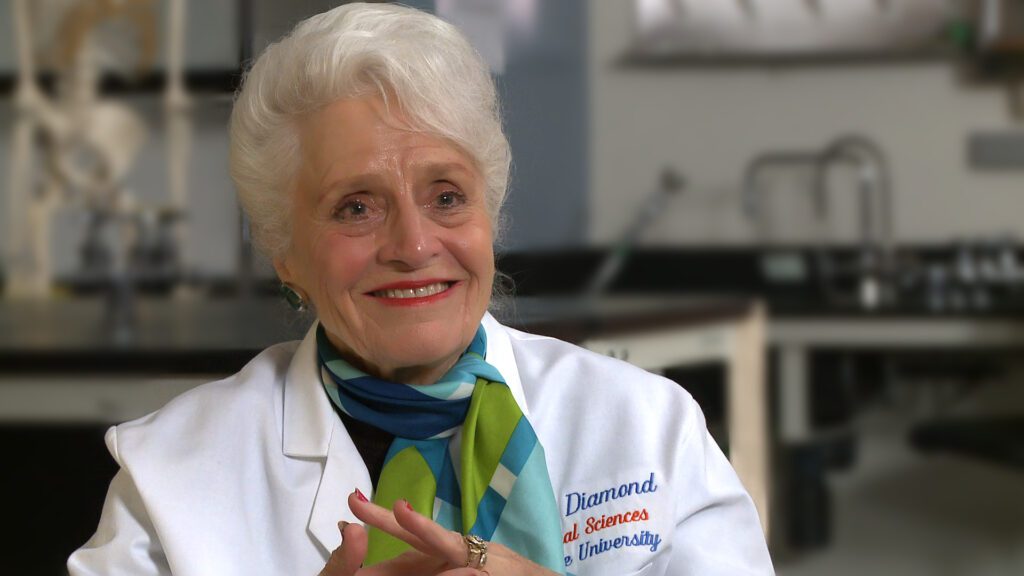

Dr. Marian Diamond, 1986, portrait photos by Eric Luse, San Francisco Chronicle
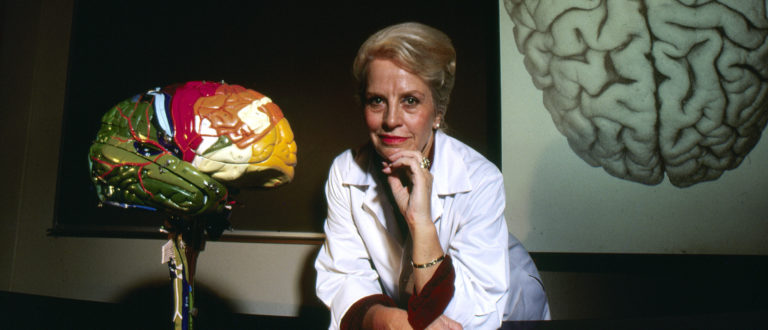
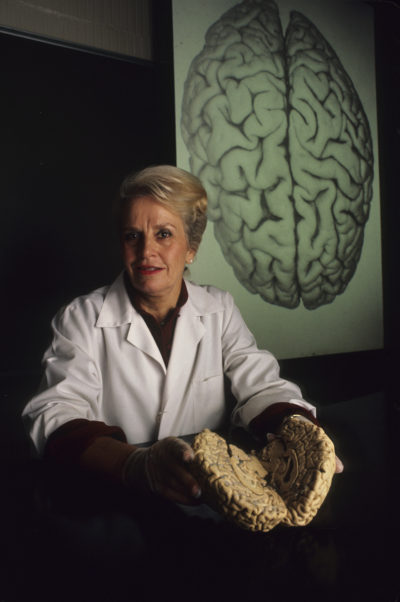
More …
(b/w 1984 portraits of Dr Marian Diamond, photos by Ed Kashi)
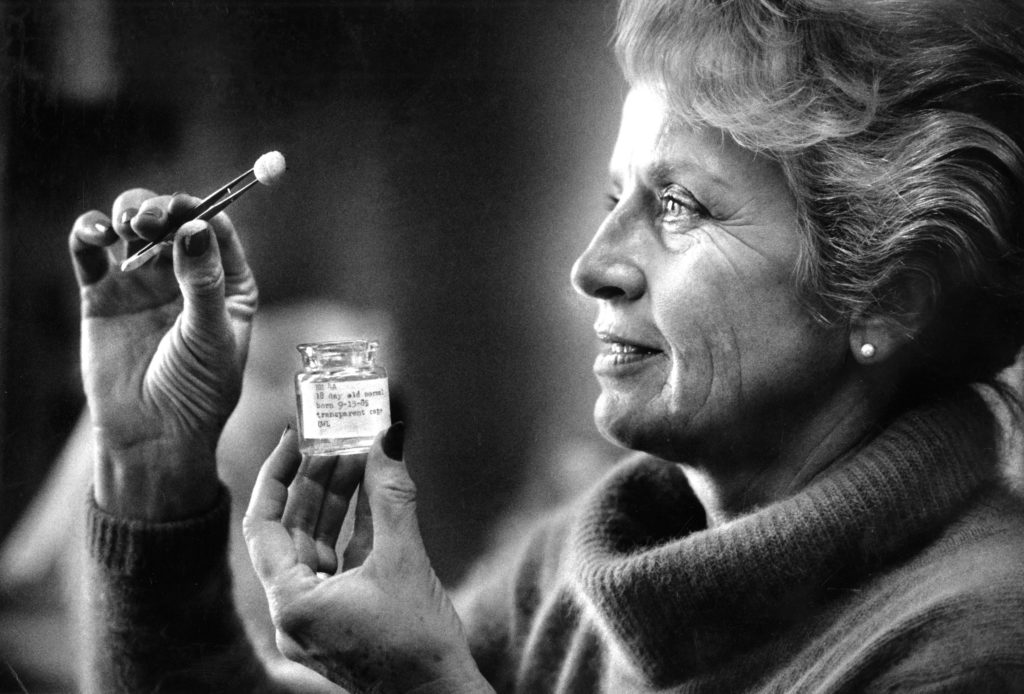
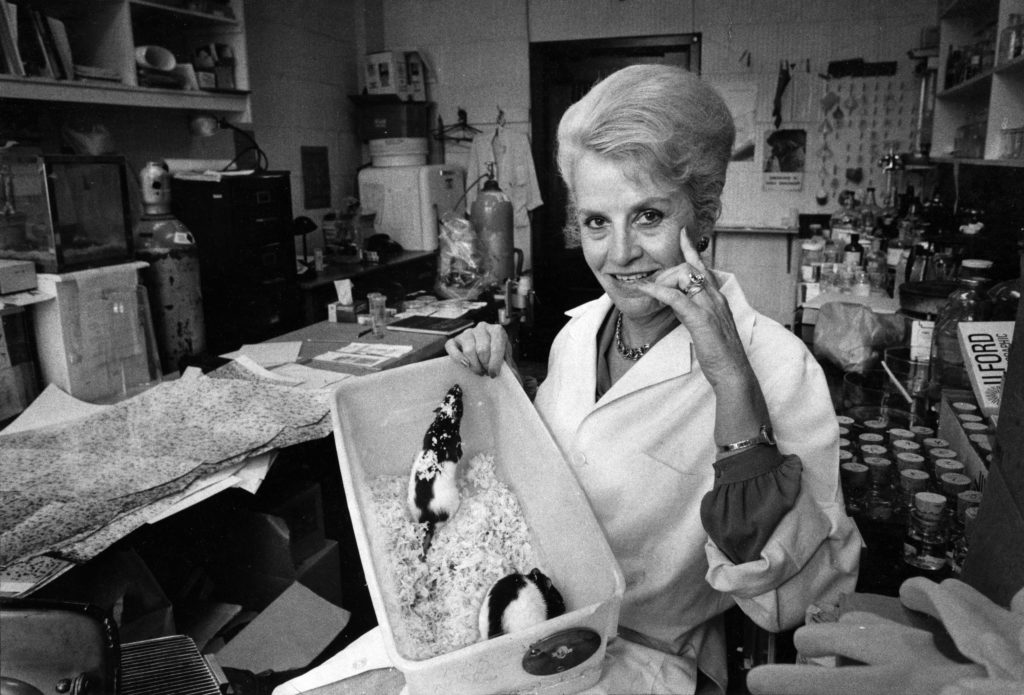
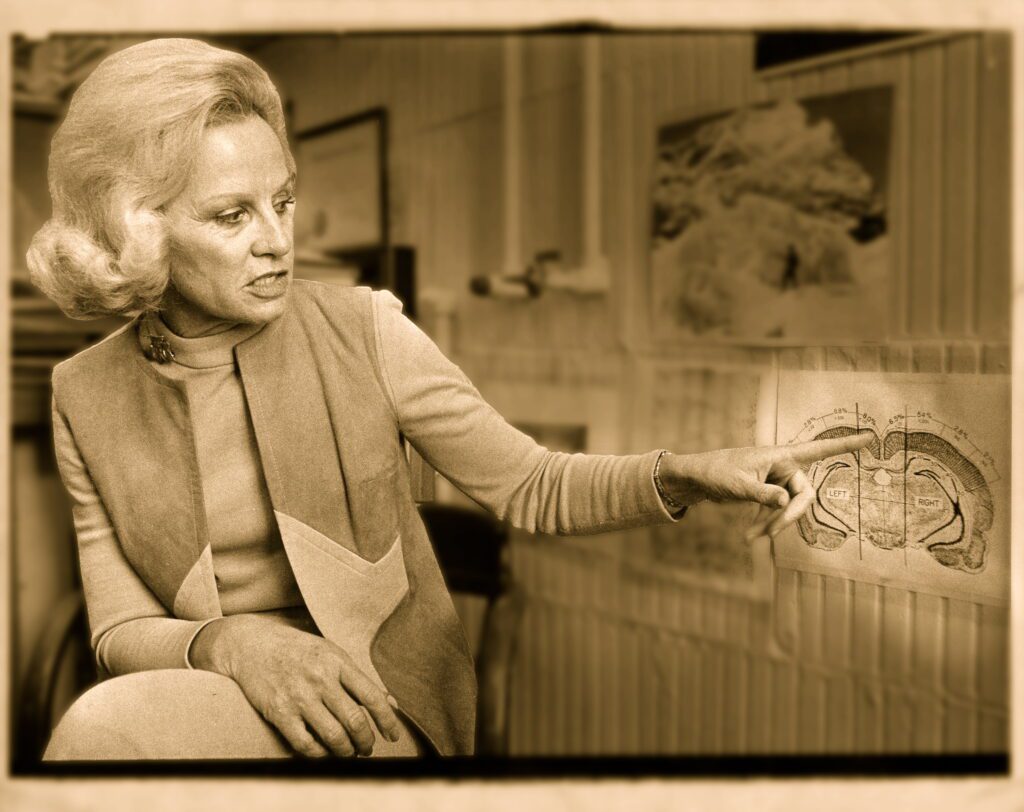
TItle over image
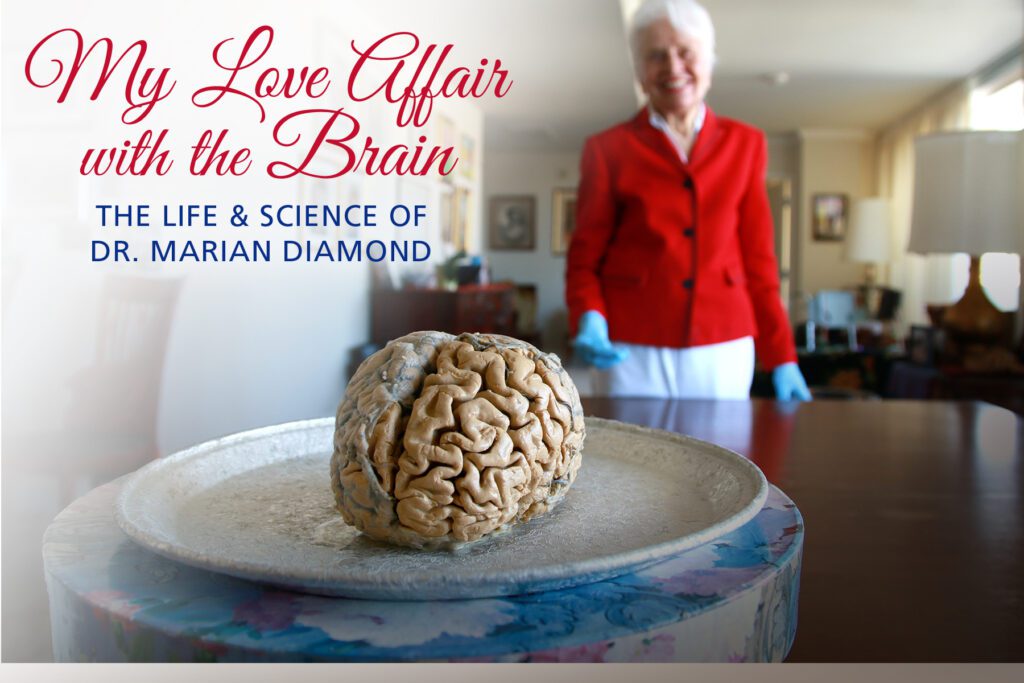
wrap around html format, pix in local media – KEEP
reviews
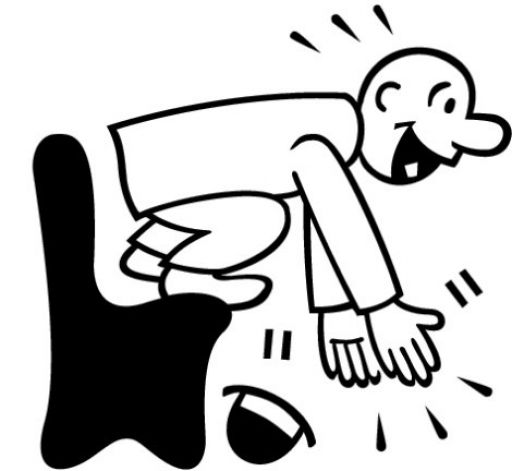
- “Remarkable … entertaining.” SF Examiner
- “A joy filled film” San Francisco Chronicle
- “Delightful …” Mercury News
- “Utterly fascinating. Diamond is a rock star.” Georgia Straight
- “Delightful.” Winston-Salem Journal
- “One of the tweedy celebrities of cyberspace” New York Times
- “If you haven’t seen it, move heaven and earth to find it… her passion to know more about the human brain became a key to a life exceptionally well lived.” David Wiegand, Film Reviewer
try 'em, it's all for you
More Links
See, hear, read for yourself. Lots available:
- Informational postcard about the film.
- 1 page promo sheet for the film
- Press Package (log line, summary, plus 18 pages of reviews)
- Promo images/graphics – download and use, for press any promo use YOU want
- Dr. Diamond's auto biography, from "The History of Neuroscience."
- Anatomy Class 1 - watch her famous YouTube Anatomy lecture series. (Jumpstart your PhD)
- TED talk by Dr. Wendy Suzuki: "The way Marian Diamond inspired me ..."
- SF Chronicle article appreciating Dr. Diamond
- Selected research publications and articles by Dr. Diamond
- "The Best Way to talk about Science." Scientific American blog on this film and Dr. Diamond
Books by Marian Diamond:
- The Human Brain Coloring Book
- Magic Trees of the Mind: How to Nurture Your Child’s Intelligence, Creativity, and Healthy Emotions from Birth Through Adolescence
- Enriching Heredity: The Impact of the Environment on the Anatomy of the Brain
Produced and Directed by
Catherine Ryan and Gary Weimberg
Written, Photographed and Edited by
Gary Weimberg
Executive Producers
Mary and Stan Friedman
Tyson Lindo
Narrator
Mayim Bialik
Original Music
Todd Boekelheide
Additional Camera
Todd Darling
Eli Jacobs Fantauzzi
Tyson Lindo
Veronica Lopez
Clare Major
Tim Metzger
Sound
Dave Wendlinger
Ian Slattery
Veronica Lopez
Associate Producers
Millie Borowiak
Dr. Jayne Hagan
Ian Slattery
Sound Editor and Digital Video Enhancement
Kevin O’Brien
Sound Mix
Jim LeBrecht, Berkeley Sound Artists
Video On-line
Heather Weaver, Reeltime Color
Story & Editorial Consultants
Todd Boekelheide
Jen Bradwell
Dr. Jayne Hagen
Bill Jersey
Dr. Norman Kachuck
John Nutt
Graphics
David Murray
Nicole Tostevin
Casey Couser
Assistant Editors
Tyson Lindo
Veronica Lopez
Max Stein
Transcriptions
Millie Borowiak
Production Intern
Alexandra Wood
Additional music
Killer Tracks
Funding
Berkeley Film Foundation
San Francisco Foundation
KQED
Fiscal Sponsor
Catticus Corporation
Special Thanks
Susan and Jim Acquistapache
Michael Astrachan
Marilyn Bancel
Todd and Linda Darling
Doug Fields
Vivian Hilgrove
Ben Hubbard
Shirley Kessler
Jill Marchant
Marcia McNutt
Mike Smith
Meg Starr
Tamara Friedman and 150 students at Berkeley High School
Maria Sheinina and 7th grade Science class, Tehiyah Day School
Works Cited
Adolphs R, Tranel D, Damasio AR
“The human amygdala in social judgment,” Psychological Science
Adolphs R, Tranel D, Damasio AR, Damasio H
“Fear and the human amygdala,” Psychological Science
Bermúdez-Rattoni, Federico
“Modification of Brain Circuits through Experience,” Genes to Brain Imaging
Bialystok, Ellen
“Reshaping the Mind: The Benefits of Bilingualism,” Psychological Science
Brito NH and Noble KG
“Socioeconomic status and structural brain development,” Psychological Science
Chung, Kwanghun, et al
“Structural and molecular interrogation of intact biological systems,” Nature
Cohen, Susan
“The Strange Fate of Einstein’s Brain,” San Jose Mercury News
Diamond, Marian C.
“Experience of the Brain,” Scientific American
“Response of the Brain to Enrichment,” Anais da Academia Brasileira de Ciencias
“Successful Aging of the Healthy Brain,” The Journal of Comparative Neurology
“The Aging Brain: Some Enlightening and Optimistic Results,” American Scientist
Diamond, Marian C. and Arnold B. Scheibel, et al
“On the Brain of a Scientist: Albert Einstein,” Experimental Neurology
Diamond, Marian C. and David Krech and Mark R. Rosenzweig
“The Effects of an Enriched Environment on the Histology of the Rat Cerebral Cortex,” The Journal of Comparative Neurology
Diamond, Marian C. and Ruth E. Johnson, et al
“Plasticity in the 904-Day-Old Male Rat Cerebral Cortex,” Experimental Neurology
Edward L. Bennett and Marian C. Diamond, David Krech, Mark R. Rozenzweig
“Chemical and Anatomical Plasticity of Brain,” Science Magazine
Fields, R. Doug
“Visualizing Calcium Signaling in Astrocytes,” Science Signaling
Gaser, Christian and Gottfried Schlaug
“Brain Structures Differ between Musicians and Non-Musicians,” The Journal of Neuroscience
“Genius Cells in the Brain?” Science Gymnasium
Goleman, Daniel
“New Evidence Points to Growth Of the Brain Even Late in Life,” New York Times
Hair NL, Hanson JL, Wolfe BL, Pollak SD
“Association of Child Poverty, Brain Development, and Academic Achievement,” Psychological Science
Hutton, John S. and Tzipi Horowitz-Kraus, et al
“Home Reading Environment and Brain Activation in Preschool Children Listening to Stories,” Pediatrics
Jabr, Ferris
“Taxi Drivers’ Brains Grow to Navigate London’s Streets,” Scientific American
Johansson, Barbro B., MD, PhD
“Brain Plasticity and Stroke Rehabilitation,” Stroke
Maguire EA, Woollet K, Spiers HJ
“London taxi drivers and bus drivers: a structural MRI and neuropsychological analysis,” Hippocampus
Maranito, Gina
“The Bizarre Fate of Einstein’s brain,” Discover
Pescovitz, David
“Improving Impoverished Children’s Brains,” Science Matters
Pollok, Bettina and Irmtraud Schnitzler, et al
“Image to Sound Conversion: Experience Induced Plasticity in Auditory Cortex of Blindfolded Adults,” Experimental Brain Research
Ratnaparkhi, Anuradha
“The secreted cell signal Folded Gastrulation regulates glial morphogenesis and axon guidance in Drosophila,” Psychological Science
Skoe E, Krizman J, Kraus N.
“The impoverished brain: disparities in maternal education affect the neural response to sound,” Psychological Science
Smith, Kerri
“Settling the Great Glia Debate,” Nature Magazine
Spunt RP, Lieberman MD
“The Busy Social Brain,” Psychological Science
Tang YY, Hölzel BK, Posner MI
“The neuroscience of mindfulness meditation,” Psychological Science
Telzer, Eva H. and Andrew Fuligni, et al
“The effects of poor quality sleep on brain function and risk taking in adolescence,” Psychological Science
Turner, Beth M. and Sergio Paradiso, et al
“The Cerebellum and Emotional Experience,” Psychological Science
Van Praag, Henriette and Brian R. Christie, et al
“Running enhances neurogenesis, learning, and long-term potentiation in mice,” Psychological Science
Articles courtesy of:
Associated Press
The Daily Californian
Discovery Health Magazine
Experimental Neurology
The Journal of Comparative Neurology
Nature
New York Times
Oakland Tribune
San Francisco Chronicle
Scientific American
Time Magazine
Washington Post
Photos courtesy of:
American Association of Anatomists
Berkeleyside
California Historical Society
Cushing/Whitney Medical Historical Library Yale University
Exploratorium
Library of Congress
San Francisco Chronicle
Science Photo Library
Shirsa Labs
Time Magazine
Bruce Blauso
Neil Conway
Dr. Marian C. Diamond
Rick Diamond
Dr. Robert E. Goldsby
Don W. Jones
Ed Kashi
Gaetan Lee
Donna Magazine
Carole Miller
Dr. Kedar Che Prasad
Dr. Arnold Scheibel
Peg Skorpinski
Dr. Wendy Suzuki
Footage courtesy of:
Annenberg Media
ASCD
BBC
Benjamin Ide Wheeler Society
Beyond 2000
Biosphera.com
CriticalPast
KRON
Nightline with Ted Koppel, ABC News
Pond 5
Sex Differences in the Brain: Brown Bag Lunch w Marian Diamond
University of California, Regents
XVIVO Scientific Animation
BigBrain, courtesy of:
Dr. Alan Evans, Montreal Neurological Institute, McGill University
Davidson Films:
Older Brains, New Connections
Lawrence Hall of Science, U.C. Berkeley:
Within the Human Brain: A Dissection by Marian C. Diamond
© Luna Productions 2016
Research and writing
CREDITS
Scientific works cited, and on-screen credit list
credits
For the PBS broadcast, credits were limited to 30 seconds, so the full end credits were (sadly but necessarily) abbreviated.
Listed here at full length are:
- the 36 scientific works specifically cited in the film
- the complete on-screen tail credits for crew and supporters (which were included in the film festival version of the documentary cuz that wasnt limited by PBS rules or the brutality of old-school-limited-to-one-hour broadcast methods
Scientific works cited in the film
Ralph Adolphs, Daniel Tranel, Antonio R. Damasio
“The human amygdala in social judgment,” Nature
Ralph Adolphs, Daniel Tranel, Antonio R. Damasio, Hanna Damasio
“Fear and the human amygdala,” The Journal of Neuroscience
Bermúdez-Rattoni, Federico
“Modification of Brain Circuits through Experience,” Genes to Brain Imaging
Bialystok, Ellen
“Reshaping the Mind: The Benefits of Bilingualism,” Canadian Journal of Experimental Psychology
Brito, Natalie H and Noble, KimberlyG
“Socioeconomic status and structural brain development,” Frontiers in Neuroscience
Chung, Kwanghun, et al
“Structural and molecular interrogation of intact biological systems,” Nature
Cohen, Susan
“The Strange Fate of Einstein’s Brain,” San Jose Mercury News
Diamond, Marian C.
“Experience of the Brain,” Scientific American
“Response of the Brain to Enrichment,” Anais da Academia Brasileira de Ciencias
“Successful Aging of the Healthy Brain,” The Journal of Comparative Neurology
“The Aging Brain: Some Enlightening and Optimistic Results,” American Scientist
Diamond, Marian C. and Arnold B. Scheibel, et al
“On the Brain of a Scientist: Albert Einstein,” Experimental Neurology
Diamond, Marian C. and David Krech and Mark R. Rosenzweig
“The Effects of an Enriched Environment on the Histology of the Rat Cerebral Cortex,” The Journal of Comparative Neurology
Diamond, Marian C. and Ruth E. Johnson, et al
“Plasticity in the 904-Day-Old Male Rat Cerebral Cortex,” Experimental Neurology
Edward L. Bennett and Marian C. Diamond, David Krech, Mark R. Rozenzweig
“Chemical and Anatomical Plasticity of Brain,” Science Magazine
Fields, R. Doug
“Visualizing Calcium Signaling in Astrocytes,” Science Signaling
Gaser, Christian and Gottfried Schlaug
“Brain Structures Differ between Musicians and Non-Musicians,” The Journal of Neuroscience
“Genius Cells in the Brain?” Science Gymnasium
Goleman, Daniel
“New Evidence Points to Growth Of the Brain Even Late in Life,” New York Times
Hair NL, Hanson JL, Wolfe BL, Pollak SD
“Association of Child Poverty, Brain Development, and Academic Achievement,” JAMA Pediagtrics
Hutton, John S. and Tzipi Horowitz-Kraus, et al
“Home Reading Environment and Brain Activation in Preschool Children Listening to Stories,” Pediatrics
Jabr, Ferris
“Taxi Drivers’ Brains Grow to Navigate London’s Streets,” Scientific American
Johansson, Barbro B., MD, PhD
“Brain Plasticity and Stroke Rehabilitation,” Stroke
Maguire EA, Woollet K, Spiers HJ
“London taxi drivers and bus drivers: a structural MRI and neuropsychological analysis,” Hippocampus
Maranito, Gina
“The Bizarre Fate of Einstein’s brain,” Discover
Pescovitz, David
“Improving Impoverished Children’s Brains,” Science Matters
Pollok, Bettina and Irmtraud Schnitzler, et al
“Image to Sound Conversion: Experience Induced Plasticity in Auditory Cortex of Blindfolded Adults,” Experimental Brain Research
Ratnaparkhi, Anuradha
“The secreted cell signal Folded Gastrulation regulates glial morphogenesis and axon guidance in Drosophila,” Psychological Science
Skoe E, Krizman J, Kraus N.
“The impoverished brain: disparities in maternal education affect the neural response to sound,” The Journal of Neuroscience
Smith, Kerri
“Settling the Great Glia Debate,” Nature Magazine
Spunt RP, Lieberman MD
“The Busy Social Brain,” Psychological Science
Tang YY, Hölzel BK, Posner MI
“The neuroscience of mindfulness meditation,” Nature Reviews Neuroscience
Telzer, Eva H. and Andrew Fuligni, et al
“The effects of poor quality sleep on brain function and risk taking in adolescence,” Neuroimage
Turner, Beth M. and Sergio Paradiso, et al
“The Cerebellum and Emotional Experience,” Neuropsychologia
Van Praag, Henriette and Brian R. Christie, et al
“Running enhances neurogenesis, learning, and long-term potentiation in mice,” Prodeedings of the National Academy of Sciencies

Complete film Credits
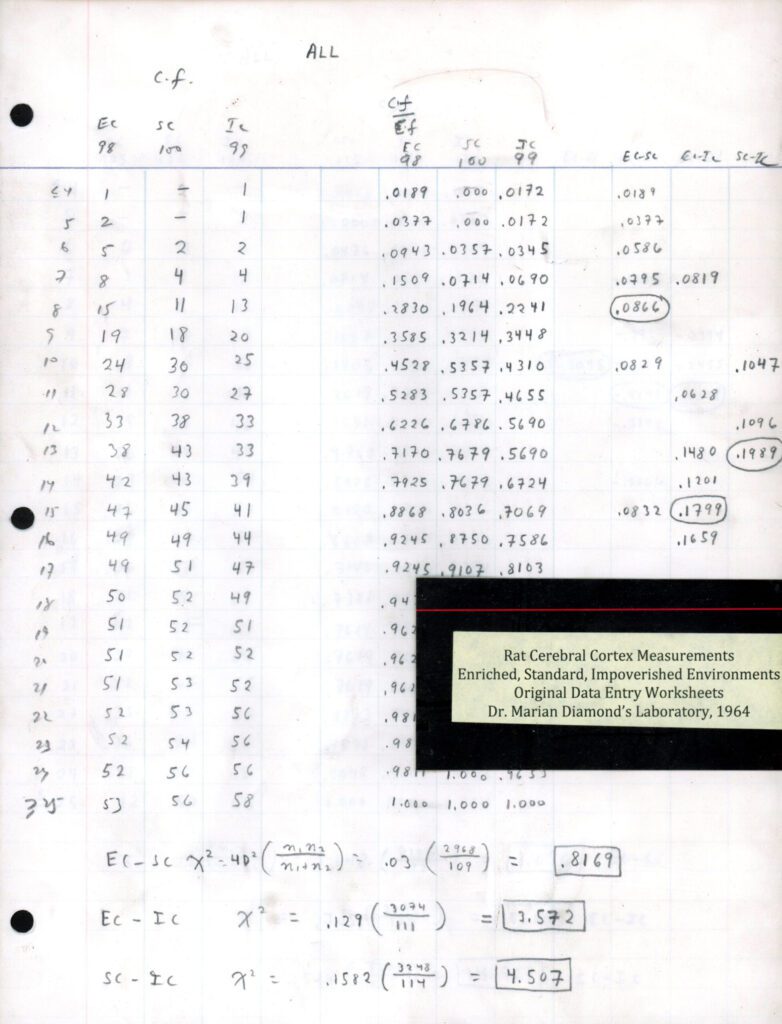
Rat Cerebral Cortex Measurements, original data entry worksheet from Dr. Diamond’s laboratory, 1964 (click for full size)
(Note: pencil and paper … so’ back in the day’, eh?)
BOOKS
Magic Trees of the Mind: How to Nuture you Child’s Intelligence, Creativity, and Healthy Emotions from Birth, by Marian Diamond and Janet Hopson, 1999
The Human Brain Coloring Book, by Marian C. Diamond and Arnold B. Scheibel, 1985
Enriching Heredity: The Impact of the Environment on the Anatomy of the Brain, by Marian Cleeves Diamond, 1988
Reviews and quotes 2 text
“…prepare to be smitten …”
DOXA, Vancouver, Canada
“…a joy filled film …”
SAN FRANCISCO CHRONICLE
“Brilliant, buoyant, enlightening and beautiful …”
JOYCE CAROL OATES, Author
“… a must see for every student, teacher, parent, community member, and higher education teacher prep program!”
PEGGY BROOKINS, President and CEO, National Board for Professional Teaching Standards
“Marian Diamond has made two major contributions to Neural Science that have stood the test of time. …. Bravo!”
Dr. ERIC R. KANDEL, Nobel Prize Winner
“Reveals the soul of science through the remarkable life of Marian Diamond.”
R. DOUGLAS FIELDS, Neuroscientist and Author
“A feel good firsthand account of the neuroscience icon’s life and work”
SCIENCE Magazine
“… should be required viewing for all students and professionals in gerontology, geriatrics, and adult development and aging… “
The GERONTOLOGIST
 “… part biography, part scientific adventure story, and part inspirational tale about one of the founders of modern neuroscience,”
“… part biography, part scientific adventure story, and part inspirational tale about one of the founders of modern neuroscience,”
Scientific American Blog,“What’s the Best Way to talk about Science?”
“Marian Diamond’s love for the brain is infectious…. remarkable .. entertaining.”
SF Examiner
“one of the tweedy celebrities of cyberspace”
New York Times
” … utterly fascinating … Diamond is a rock star …”
The Georgia Straight, Vancouver, Canada
 “… delightful …”
“… delightful …”
Winston-Salem Journal
“… the multifaceted career of a “brain whisperer … “
The University of California NEWS
“Not only a wonderful film about an amazing scientist but also about an extraordinary teacher. “
LINDA JENSEN DARLING, Teacher Education, Dept of Applied Linguistics, UCLA.
“Any library would be well served to have this in their collection.”
SUSAN KOSKINEN, Head, Life & Health Sciences Library, U.C. Berkeley
 “… charming, funny, easy to understand, and twinkles with enthusiasm.” BERKELEYSIDE
“… charming, funny, easy to understand, and twinkles with enthusiasm.” BERKELEYSIDE
” … utterly charming, inspiring documentary…”
The Stark Insider
“… a thrilling and inspiring film about one of the great teachers and pioneers of neuroscience”
CHARLES G. GROSS, Professor Emeritus of Psychology and the Princeton Neuroscience Institute
 “Dr. Diamond achieved every success with steely determination behind astonishing positivity, warmth, and magnetism. Watch this to learn about an amazing woman, a brilliant scientist, a fascinating branch of scientific research, and about the core element that fuels great achievement in all endeavors: love.”
“Dr. Diamond achieved every success with steely determination behind astonishing positivity, warmth, and magnetism. Watch this to learn about an amazing woman, a brilliant scientist, a fascinating branch of scientific research, and about the core element that fuels great achievement in all endeavors: love.”
MILL VALLEY FILM FESTIVAL
“This film, like Marian Diamond herself, is an inspiration.”
BOB JACOBS, Professor of Neuroscience, Colorado College
 “Marian Diamond is to the brain like Julia Childs is to French cooking.”
“Marian Diamond is to the brain like Julia Childs is to French cooking.”
MARILYN BANCEL,Exploratorium Science Museum, Director of Development, (retired)
.a
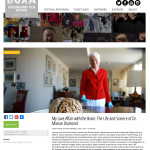 Full text: How can you not fall in love with a woman who carries around a preserved human brain inside a giant flowery hat box? Meet Dr. Marian Diamond, renowned academic and research scientist, and prepare to be smitten.
Full text: How can you not fall in love with a woman who carries around a preserved human brain inside a giant flowery hat box? Meet Dr. Marian Diamond, renowned academic and research scientist, and prepare to be smitten.
Catherine Ryan and Gary Weimberg’s film follows this remarkable woman over a 5-year period and introduces the viewer to both her many scientific accomplishments and the warm, funny, and thoroughly charming woman herself, who describes her 60-year career researching the human brain as “pure joy.”
As one of the founders of modern neuroscience, it’s no exaggeration to say that Dr. Diamond changed science, and society at large in dramatic ways over the course of her career. Her groundbreaking work is all the more remarkable because it began during an era when so few women entered science at all. Shouted at from the back of the conference hall by noteworthy male academics as she presented her research, and disparaged in the scientific journals of a more conservative era, Dr. Diamond simply did the work and followed where her curiosity led her, bringing about a paradigm shift (or two) in the process.
As she points out, in order to get to the answers that matter, you have to start by asking the right questions.
from Doxa, Documentary Film Festival, Vancouver, Canada.
…..
![]() .
.
…..
” If her name isn’t yet as familiar as that of Marie Curie, it will be.”
…..
Full text and tickets: Meet Dr. Marian Diamond as she pulls a human brain out of a hatbox and lovingly enumerates its astonishing qualities. A mad scientist? Quite the opposite. In this energetic documentary, Dr. Diamond is revealed as one of the great minds—one of the founders, in fact—of modern neuroscience. If her name isn’t yet as familiar as that of Marie Curie, it will be: Dr. Diamond’s unprecedented work includes theorizing and proving previously unimagined brain capabilities, analyzing Albert Einstein’s preserved brain, and building a scientific and academic career that broke barriers for women in science. Much like the old adage about Ginger Rogers doing it all backwards and in heels, Dr. Diamond achieved every success with steely determination behind astonishing positivity, warmth, and magnetism. Watch this to learn about an amazing woman, a brilliant scientist, a fascinating branch of scientific research, and about the core element that fuels great achievement in all endeavors: love.
from Mill Valley Film Festival – where we also received an Audience Favorite Award!
…..
![]() .
.
…..
“…inspirational…”
“Science has a soul, an intangible passion of the human spirit driven by wonder and delight in discovery of nature’s beauty and intricate mysteries. My Love Affair with the Brain reveals the soul of science through the remarkable life of Marian Diamond. Her passion to explore the brain, her keen insights into how it responds to our experiences, and her drive to share her enchantment and discoveries with a new generation shines in this inspirational documentary.”
R. DOUGLAS FIELDS, Neuroscientist and Author of The Other Brain, and Why We Snap
…..
![]() .
.
…..
 “… part biography, part scientific adventure story, and part inspirational tale about one of the founders of modern neuroscience, Dr. Marian C. Diamond, Professor Emeritus at University of California, Berkeley. It is no exaggeration to say that her research changed not only science, but the world. “
“… part biography, part scientific adventure story, and part inspirational tale about one of the founders of modern neuroscience, Dr. Marian C. Diamond, Professor Emeritus at University of California, Berkeley. It is no exaggeration to say that her research changed not only science, but the world. “
Scientific American Blog, “What’s the Best Way to talk about Science?”
…..
![]() .…..
.…..
…..” … utterly fascinating …”
.
full text: “Dr. Marian Diamond keeps a preserved human brain in a delicate hatbox, eagerly uncovering the spongy organ for anyone who shows even the faintest of interest. And it is utterly fascinating.”
“A revolutionary figure in modern neuroscience, Diamond is a rock star as seen through the lens of filmmakers Catherine Ryan and Gary Weimberg. Her groundbreaking studies are chronicled with care, offering a thoroughly inspiring crash-course in human anatomy that many academics still take for granted today.”
“But even more captivating than the research is the woman herself: a subject of undying curiosity, charm, and an infectious zeal—even in the face of rampant sexism—which makes the answer to her question, “Don’t you just love the brain?”—ahem—a no-brainer.”
The Georgia Straight
Weekly newspaper of Vancouver, British Columbia, Canada.
.
..![]() ..
..
 National Science Teachers Association, podcast
National Science Teachers Association, podcast
“Listen to the show to be inspired by Dr. Diamond’s work and learn how you might use her story in your science classroom and participate in this public engagement in science.”
20 minute interview about “My Love Affair with the Brain: The Life and Science of Dr. Marian Diamond” on “Lab Out Loud” podcast
American Library Association (ALA)
names “My Love Affair with the Brain”
as one of the 15 outstanding
“Notable Videos for Adults” for 2019
.…..
![]() .…..
.…..
 The Gerontologist
The Gerontologist
…..“…the film succeeds marvelously … As gerontologists, we owe a debt of gratitude to Marian Diamond …”
. The Gerontologist, the peer reviewed journal of The Gerontological Society of America.
.
Winston-Salem Journal
The first review, April 6th, 2016, reviewed as part of the RiverRun film festival.
…..“With characteristic good humor …”
.
Full Text: “With characteristic good humor, this delightful film about a pioneering brain scientist opens with the warning: “The inside of the body can be messy.” Marian Diamond doggedly and good-naturedly pursued research on the human brain in the face of resistance from the scientific community. “My Love Affair with the Brain” documents her charm and intelligence and shows how she proved that the brain can be changed and enriched throughout its life, as well as the likely link between being positive and a strong immune system.”
. .…..
.…..
From U.C. Berkeley:
Brain scientist Marian Diamond subject of new documentary
.
…..“Film covers the multifaceted career of a “brain whisperer … “
.
“… covers the personal, scientific and teaching career of a neuroscientist who changed the way we think about the brain and eventually became a YouTube celebrity and role model for women.”
“What she revealed about the brain allows us to get the most out of our brain, not just as children but for our entire lives,” according to the producers. “She is a beloved professor, worthy role model, especially for women and girls in science, and all-around brain whisperer.”
“Her lectures, which often ended in applause, earned her many teaching awards, while her research on the brain inspired many others to take up brain research, pursue science or just nurture their curiosity about nature.”
University of California News, click here for whole article.
. …...
…...
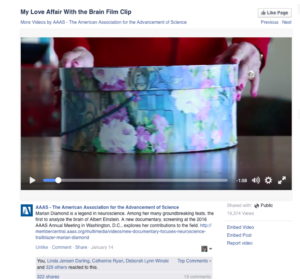
AAAS Facebook: World Premiere of ‘My Love Affair’ Announced
.
including delicious comments such as “No zombie ever loved brains as much as this eloquent, stylish researcher-lady.”
.
AAAS is the American Association for the Advancement of Science, publisher of the prestigious Science magazine, and the largest general interest science organization in the world.
Three weeks after the original posting on AAAS site, this video had over 19,000 views, the most that AAAS has ever had for any post or video. View here
. .……..
.……..
 From Mercury News: “… delightful … “
From Mercury News: “… delightful … “
If you couldn’t make it to the Mill Valley Film Festival, you missed the delightful “My Love Affair With the Brain,” a documentary from Catherine Ryan and Gary Weimberg about the remarkable achievements of retired Cal professor Dr. Marian Diamond. But you’re in luck … (continued here)
. .…..
.…..
 From Oakland Magazine: “… fascinating …”
From Oakland Magazine: “… fascinating …”
This classic 50s B-movie about a lab-coat wearing, beaker-carrying scientist who finds herself falling for a suave disembodied brain from another world is – what? Oh. Never mind, it’s the equally fascinating story of Berkeley anatomy professor and trail-blazing brain researcher Dr. Marian Diamond. (continued here)
. .…..
.…..
” … a powerful tool to encourage scientific literacy and spreading this role model for women and girls in STEM.”
AAAS MemberCentral
(American Association for the Advancement of Science, the world’s largest general interest science organization)

 “A brilliant, buoyant, enlightening and beautiful film that achieves just the right balance between the ‘personal’ and the ‘scientific.’
“A brilliant, buoyant, enlightening and beautiful film that achieves just the right balance between the ‘personal’ and the ‘scientific.’
JOYCE CAROL OATES, Author; Distinguished Professor of Humanities, Princeton University; member of the American Academy of Arts and Letters
 … should be required viewing for all students and professionals in gerontology, geriatrics, and adult development and aging. It offers an intimate introduction to Dr. Marian Diamond, one of the most important contributors to our understanding of the growth potential of the aging brain. The film shares the story of her revolutionary work in the 1960’s that showed that the human brain can continue to develop throughout life….Today’s “New Gerontology” paradigm descends directly from Dr. Diamond’s scientific and instructional efforts to nullify false stereotypes of aging. The video also displays her long and continuing career as a mentor and inspirational model for new generations of gerontologists. The film has high relevance for students of science in general, especially those interested in scientific revolutions.
… should be required viewing for all students and professionals in gerontology, geriatrics, and adult development and aging. It offers an intimate introduction to Dr. Marian Diamond, one of the most important contributors to our understanding of the growth potential of the aging brain. The film shares the story of her revolutionary work in the 1960’s that showed that the human brain can continue to develop throughout life….Today’s “New Gerontology” paradigm descends directly from Dr. Diamond’s scientific and instructional efforts to nullify false stereotypes of aging. The video also displays her long and continuing career as a mentor and inspirational model for new generations of gerontologists. The film has high relevance for students of science in general, especially those interested in scientific revolutions.
RICK J. SCHEIDT, College of Human Ecology, Kansas State University
 “Marian Diamond is a true trailblazer. As a neuroscientist and anatomist, she helped revolutionize our understanding of brain function, particularly with regard to neural plasticity. Her pioneering work continues to drive new discoveries in healthcare and education. The entire field of Neural Rehabilitation owes her a debt of gratitude for providing early evidence that with the right type of stimulation, we can indeed change the brain. As a result, we have completely changed how we treat individuals with stroke and other neurological problems.
“Marian Diamond is a true trailblazer. As a neuroscientist and anatomist, she helped revolutionize our understanding of brain function, particularly with regard to neural plasticity. Her pioneering work continues to drive new discoveries in healthcare and education. The entire field of Neural Rehabilitation owes her a debt of gratitude for providing early evidence that with the right type of stimulation, we can indeed change the brain. As a result, we have completely changed how we treat individuals with stroke and other neurological problems.
Over decades, Marian persevered and maintained a positive outlook in the face of adversity, especially when it came to the male-dominated scientific culture of the time. This film is not only an important archive of the history of Marian Diamond’s ground-breaking work during a time when very few women could be found in the upper echelons of science, but it also is a reminder of how one person can have a profound effect on enhancing knowledge and the quality of life across the globe. Her life serves as an inspiration to millions and likely will continue to do so for years to come.”
ALISON L. MCKENZIE, Crean College of Health and Behavioral Science, Chapman University

“Not only a wonderful film about an amazing scientist but also about an extraordinary teacher. As a teacher trainer in the Department of Applied Linguistics at UCLA for over twenty years, I strongly urge college/university teacher training programs across the country to use this film as an example of effective classroom instruction for future secondary and post-secondary teachers. “
LINDA JENSEN DARLING, Teacher Education, Dept of Applied Linguistics, UCLA.
 “A must see movie for anyone with a curiosity about the brain and the history of brain science. It follows the world famous Dr. Marian Diamond as she discovers that we can change and grow our brain circuits at any age.”
“A must see movie for anyone with a curiosity about the brain and the history of brain science. It follows the world famous Dr. Marian Diamond as she discovers that we can change and grow our brain circuits at any age.”
LOUANN BRIZENDINE MD, Professor of Clinical Psychiatry, Lynne and Marc Benioff Endowed Professor of Clinical Psychiatry, UCSF Weill Institute for Neurosciences, University of California, San Francisco
 “… a thrilling and inspiring film about one of the great teachers and pioneers of neuroscience, Marian Diamond, who taught at Berkeley well into her 80’s. The film shows how she was such an incomparable teacher and mentor to generations of students and how she was among the first to demonstrate the incredible plasticity of brain; the film follows her as she applies these ideas in the real world.”
“… a thrilling and inspiring film about one of the great teachers and pioneers of neuroscience, Marian Diamond, who taught at Berkeley well into her 80’s. The film shows how she was such an incomparable teacher and mentor to generations of students and how she was among the first to demonstrate the incredible plasticity of brain; the film follows her as she applies these ideas in the real world.”
CHARLES G. GROSS, Professor Emeritus of Psychology and the Princeton Neuroscience Institute
 “Marian had the inner strength to not only find a career path for herself despite a pretty misogynistic culture, but also had the ability to become the role model that so many women needed, and still need. I’ll never forget her warmth and welcome when I was hired onto the Berkeley faculty. Marian is a scientist, a woman, a mother, a friend, a wife, and so much more because she is comfortable in all of those identities. She taught me by example that it is not only ok to wear pink in the lab, but to do so with pride. This film perfectly captures Marian. I am so happy that Luna Productions is able to bring Marian’s inspiration to such a wide audience.”
“Marian had the inner strength to not only find a career path for herself despite a pretty misogynistic culture, but also had the ability to become the role model that so many women needed, and still need. I’ll never forget her warmth and welcome when I was hired onto the Berkeley faculty. Marian is a scientist, a woman, a mother, a friend, a wife, and so much more because she is comfortable in all of those identities. She taught me by example that it is not only ok to wear pink in the lab, but to do so with pride. This film perfectly captures Marian. I am so happy that Luna Productions is able to bring Marian’s inspiration to such a wide audience.”
LESLEA J. HLUSKO Department of Integrative Biology, University of California, Berkeley
 “This film, like Marian Diamond herself, is an inspiration. It is a loving tribute to a mentor and researcher who, through her academic curiosity and intellectual generosity, has opened the doors of neuroscience to millions of individuals around the world. In the words of Cajal, it will infuse every neuron of your brain with “noble and lofty inquietudes.”
“This film, like Marian Diamond herself, is an inspiration. It is a loving tribute to a mentor and researcher who, through her academic curiosity and intellectual generosity, has opened the doors of neuroscience to millions of individuals around the world. In the words of Cajal, it will infuse every neuron of your brain with “noble and lofty inquietudes.”
BOB JACOBS, Professor of Neuroscience, Colorado College
 “Working successfully in science is in some part about finding the questions that awaken your passions for discovery and truth. As this wonderful documentary attests, it is also about how you work with others to ask the question in a way that is answerable, and thence to the stepwise approach to seeking the validity of the answers you have supposed to be attainable. Dr. Diamond was a brilliant scientist because she mastered both of these challenges, and even better, was able to communicate and educate about her love of the creative act and the rigorous personal and team-building discipline she lived as a neuroscientist. As this documentary shows, Marian was a wonderful person because in the face of the sexism of the mid-20th century science community, she persevered in her ability to share her love of science. But also she created beautiful children, a lasting bond with her wonderful husband, and, in her love of others, succeeded in so many admirable ways in her work and life.”
“Working successfully in science is in some part about finding the questions that awaken your passions for discovery and truth. As this wonderful documentary attests, it is also about how you work with others to ask the question in a way that is answerable, and thence to the stepwise approach to seeking the validity of the answers you have supposed to be attainable. Dr. Diamond was a brilliant scientist because she mastered both of these challenges, and even better, was able to communicate and educate about her love of the creative act and the rigorous personal and team-building discipline she lived as a neuroscientist. As this documentary shows, Marian was a wonderful person because in the face of the sexism of the mid-20th century science community, she persevered in her ability to share her love of science. But also she created beautiful children, a lasting bond with her wonderful husband, and, in her love of others, succeeded in so many admirable ways in her work and life.”
NORMAN KACHUCK, MD, Neurologist, Keck Medical Center of USC, (retired)

“Marian Diamond is to the brain like Julia Childs is to French cooking. Celebrated, beloved, one of the most popular teachers in the world brings you her passion about the brain. The film is a personal story about the thrill of discovery and drive of curiosity.”
MARILYN BANCEL, Exploratorium Science Museum, Director of Development, (retired)

“This movie is fantastic and tells one of the most inspiring stories in modern neuroscience. It presents such a good message of a women in a man’s field plowing her own way. I would love for all kids to watch it … so inspiring, so moving story, and what a fabulous way to tell it!! ”
DANIELA KAUFER, Associate Professor, Dept of Integrative Biology and Helen Wills Neuroscience Institute, UC Berkeley
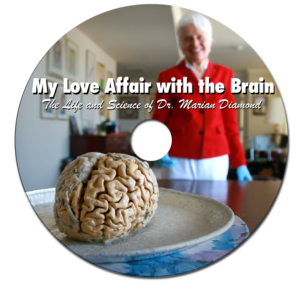 College Student questionaires:
College Student questionaires:
“This video series was one of the most interesting and entertaining videos I’ve seen. Although I had never thought of the significant founders of anatomy, I had always assumed men were ultimately responsible for the major paradigm changes as with most fields in science. It was encouraging how enthusiastic Marian was about anatomy and inspiring to remind ourselves of the excitement about how amazing science is.”

“Her love was infectious in that this love and passion for the brain are slowly creeping up on me, and I hope to be as intelligent and passionate about anatomy as she is.”

“I was really astonished and amazed by Professor’s Diamonds work, through a lot of hardships and challenges, she really is the forefront in brain plasticity and anatomical sciences. “

“This most interesting thing to me about the videos was Prof. Diamond’s discovery that an enriched environment can increase brain mass and function, because not only was it a scientific breakthrough, it is also remarkably useful information for anyone to know. It helped me see how anatomy could be useful not only for purely medical or surgical purposes, but also to promote wellness.”

“It is crazy to grasp just how much Professor Marian Diamond has accomplished, from the plethora of publications to being the first woman to receive a PhD in anatomy at Berkeley. Her videos are so inspirational and her accomplishments are what inspires me to challenge myself and become more successful.”

“Even given my indirect and very limited exposure to Professor Diamond, through her lecture videos on youtube and the documentary, her powerful and generous spirit have made her a larger-than-life figure in eyes. I am in awe of the legacy she has left on this campus and the lasting impact she has made in all of her students’ lives and the world.”

“I find it uplifting that Professor Diamond was the first woman to attend UC Berkeley’s graduate program for anatomy, seeing as that I am a woman myself. In my opinion I find it pretty awesome that she grew up to not live in fear of a strong man.”

“This video really opened my eyes to that as well as the fact that she was an incredible hopeful, inspirational, and optimistic human being. Watching this video made me want to further my education and learn more about anatomy”
Research and writings - Links to selected works by Dr. Marian Diamond2
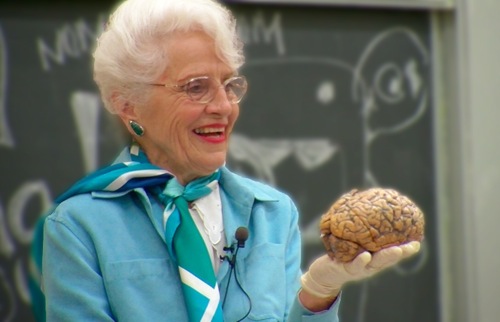 If you want learn about the PBS documentary My Love Affair With the Brain: The Life and Science of Dr. Marian Diamond, click here.
If you want learn about the PBS documentary My Love Affair With the Brain: The Life and Science of Dr. Marian Diamond, click here.
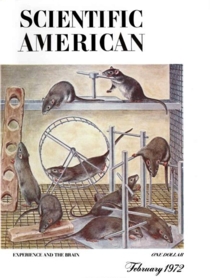 But if you want to read some of Dr. Diamonds research in her own words, you are in the right place!
But if you want to read some of Dr. Diamonds research in her own words, you are in the right place!
ARTICLES
“On the Brain of a Scientist: Albert Einstein” Marian C. Diamond, Arnold B. Scheibel, Greer m. Murphy, Jr., and Thomas Harvey Experimental Neurology, Vol. 88, pp. 198-204, 1985 “The Effects of an Enriched Environment on the Histology of the Rat Cerebral Cortex” by Marian C. Diamond, David Krech and Mark R. Rosenzweig The Journal of Comparative Neurology, Vol. 123, No. 1, August 1964 “Marian Cleeves Diamond” in The History of Neuroscience in Autobiography, Vol. 6 Marian Cleeves Diamond Society for Neuroscience, The History of Neuroscience in Autobiography Series “Women in Modern Science” Marian C. Diamond, PhD Journal of the American Medical Women’s Asssociation, Vol. 18, No 11, pp. 891-896, November 1963 “Chemical and Anatomical Plasticity of Brain: Changes in brain through experience, demanded by learning theories, are found in experiments with rats” Edward L. Bennett, Marian C. Diamond, David Krech, Mark R. Rosenzweig Science, Vol. 146, No. 3644, pp 610-619, Oct. 30, 1964 “Sex and the Cerebral Cortex” Marian Cleeves Diamond Biological Psychiatry, Vol. 25, pp 823-825, 1989 “Response of the Brain to Enrichment” Marian C. Diamond Anais da Academia Brasileira de Ciencias, Vol. 73, no. 2, Rio de Janeiro, June 2001 “Brain Changes in Response to Experience” Rats kept in a lively environment for 30 days show distinct changes in brain anatomy and chemistry compared with animals ketp in a dull environment. The implications of these effects for people are assessed. Mark R. Rosenzweig, Edward L. Bennett and Marian Cleeves Diamond Scientific American, p22-30, February 1972 “Plasticity in the 904-Day-Old Male Rat Cerebral Cortex” Marian C. Diamond, Ruth Johnson, Ann Marie Protti, Carol Ott, and Linda Kajisa Experimental Neurology 87, 309-317 (1985) “Mental stimulation increases circulating CD4-positive T lymphocytes: a preliminary study” Marian C. Diamond, Jeanne Weidner, Peter Schow, Stanley Grell, Marian Everett Cognitive Brain Research, 2001ARTIFACTS
 Rat Cerebral Cortex Measurements,
original data entry worksheet
from Dr. Diamond’s laboratory,
1964 (click for full size)
(Note: pencil and paper … so’ back in the day’, eh?)
Rat Cerebral Cortex Measurements,
original data entry worksheet
from Dr. Diamond’s laboratory,
1964 (click for full size)
(Note: pencil and paper … so’ back in the day’, eh?)
BOOKS
Magic Trees of the Mind: How to Nuture you Child’s Intelligence, Creativity, and Healthy Emotions from Birth, by Marian Diamond and Janet Hopson, 1999 The Human Brain Coloring Book, by Marian C. Diamond and Arnold B. Scheibel, 1985 Enriching Heredity: The Impact of the Environment on the Anatomy of the Brain, by Marian Cleeves Diamond, 1988

bampfa screening 2017
 2017 March & April
2017 March & April
SCREENINGS:
4pm, Friday April 28, 2017
BAMPFA,
Berkeley Art Museum and Pacific Film Archive
2155 Center Street, Berkeley, CA
Transit info and directions
tickets now available
Curated by Susan Oxtoby, Senior Film Curator
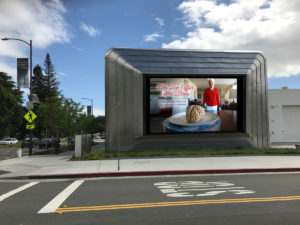
template
Lorem ipsum dolor sit amet, consectetur adipiscing elit. Ut elit tellus, luctus nec ullamcorper mattis, pulvinar dapibus leo.
Buy now (test area)
Explaination to come here: almost for free or buy it.
Choose how you want to view…
DVD also available, but discouraged cuz expensive
Related Articles
The Man Who Invented the Timeline
The timeline (when editing video) seems so obvious it's hard to imagine that someone invented it.
Download photo gallery and text (MyLAB)
photos, text, ready to use, for YOU!! For promotional or inspirational use



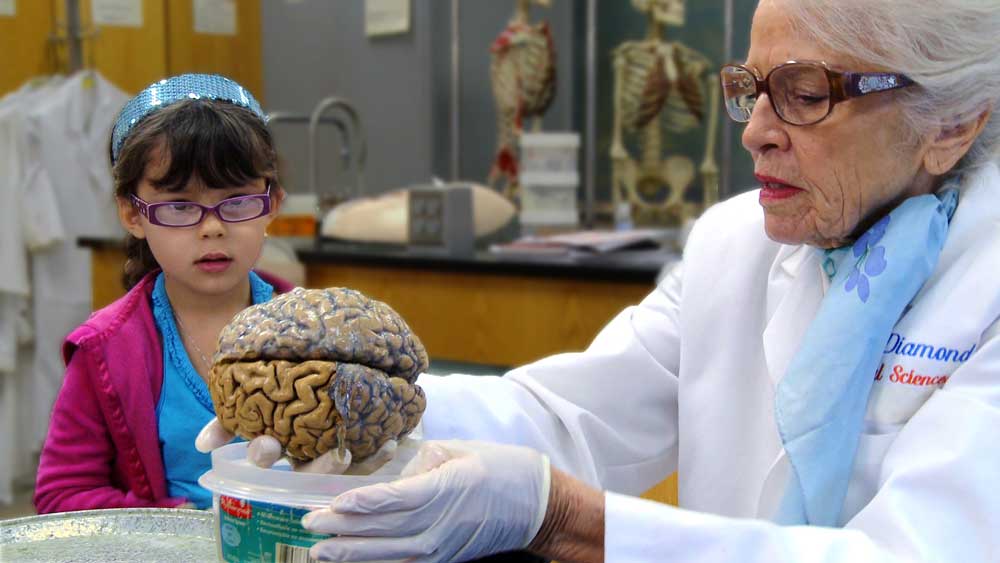
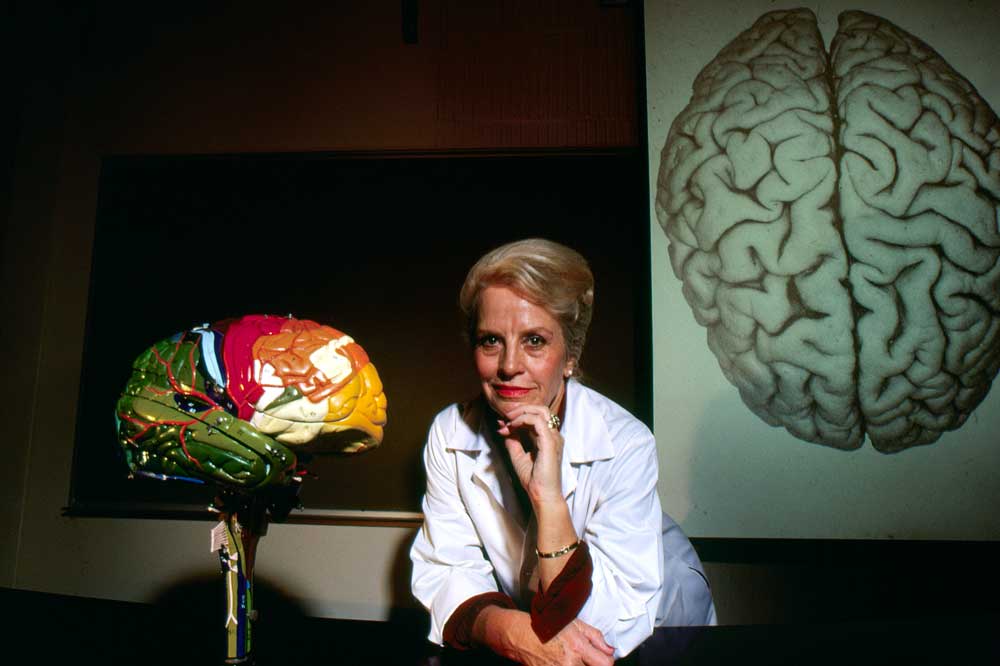
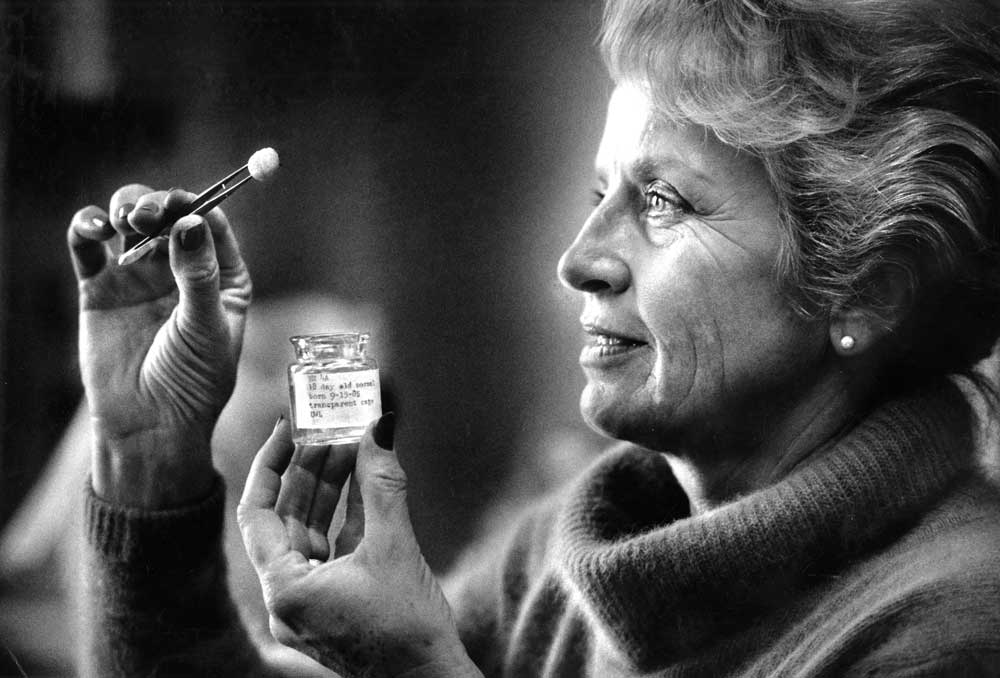
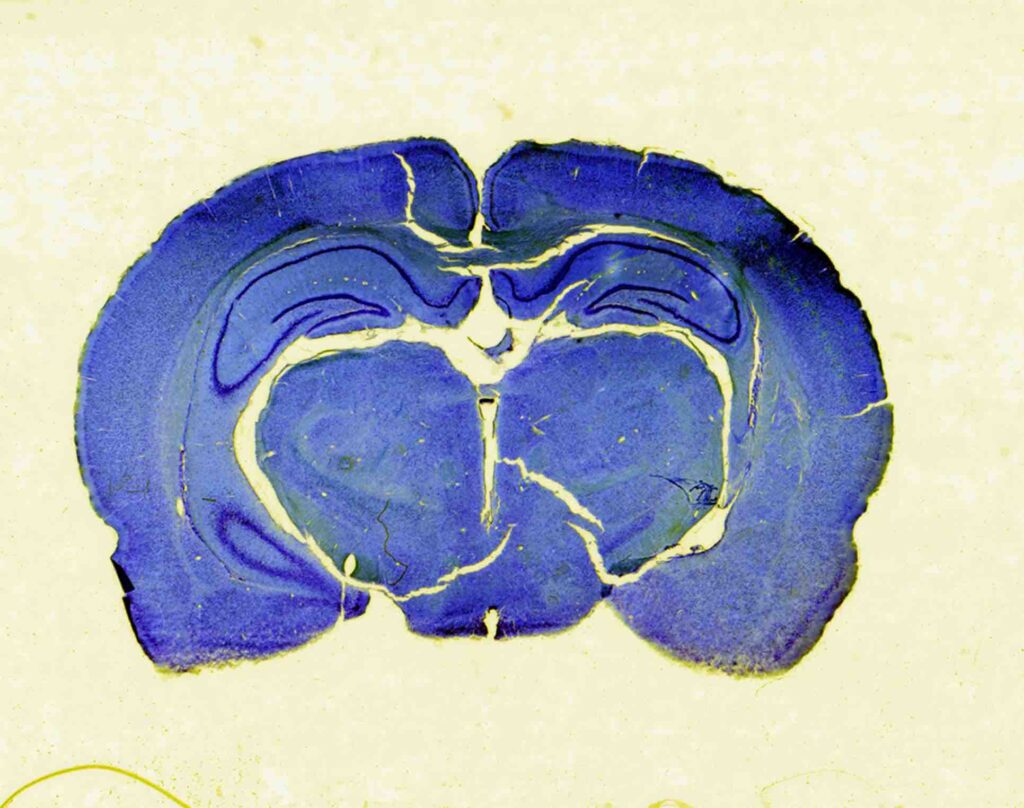

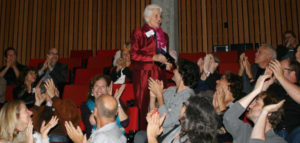


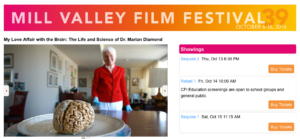
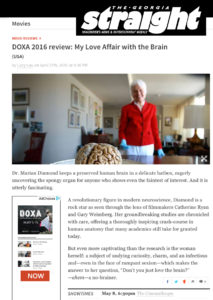




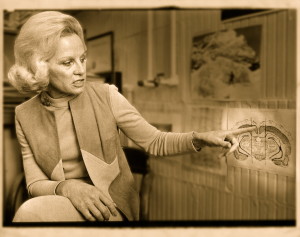 From Mercury News: “… delightful … “
From Mercury News: “… delightful … “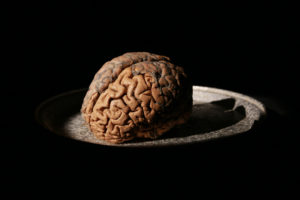 From Oakland Magazine: “… fascinating …”
From Oakland Magazine: “… fascinating …”
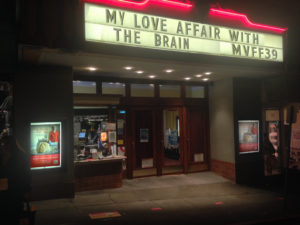

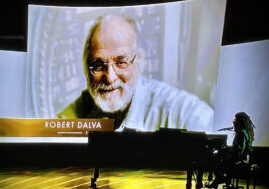
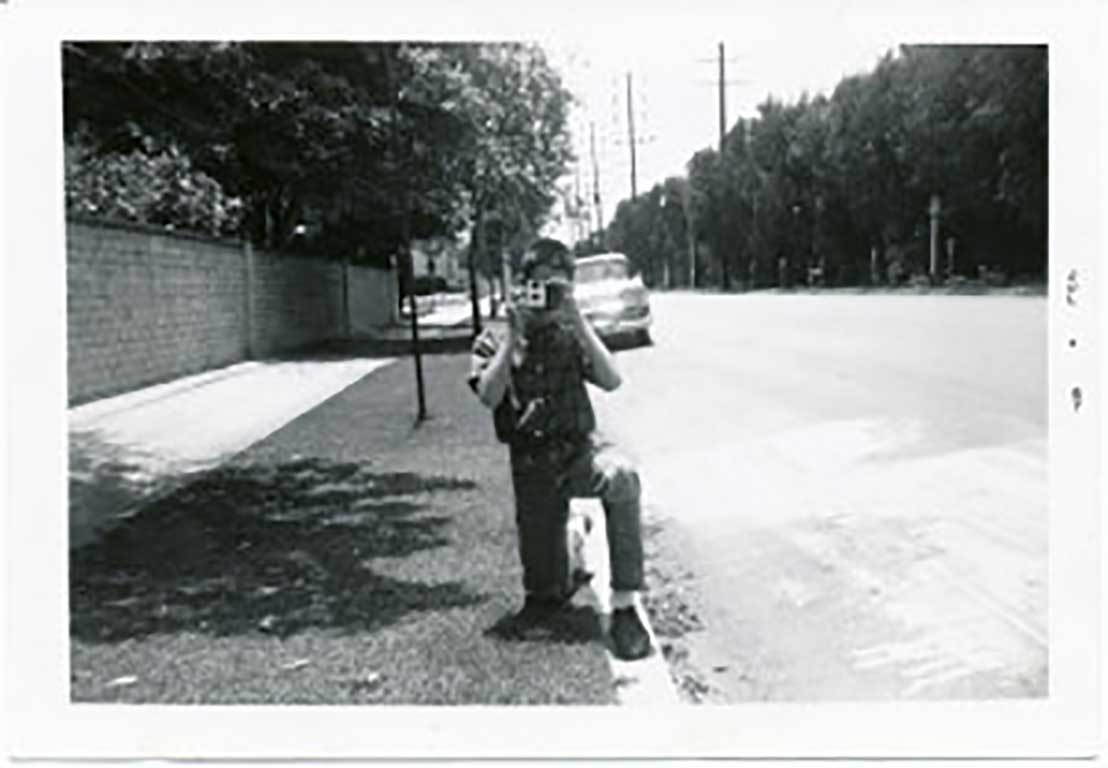
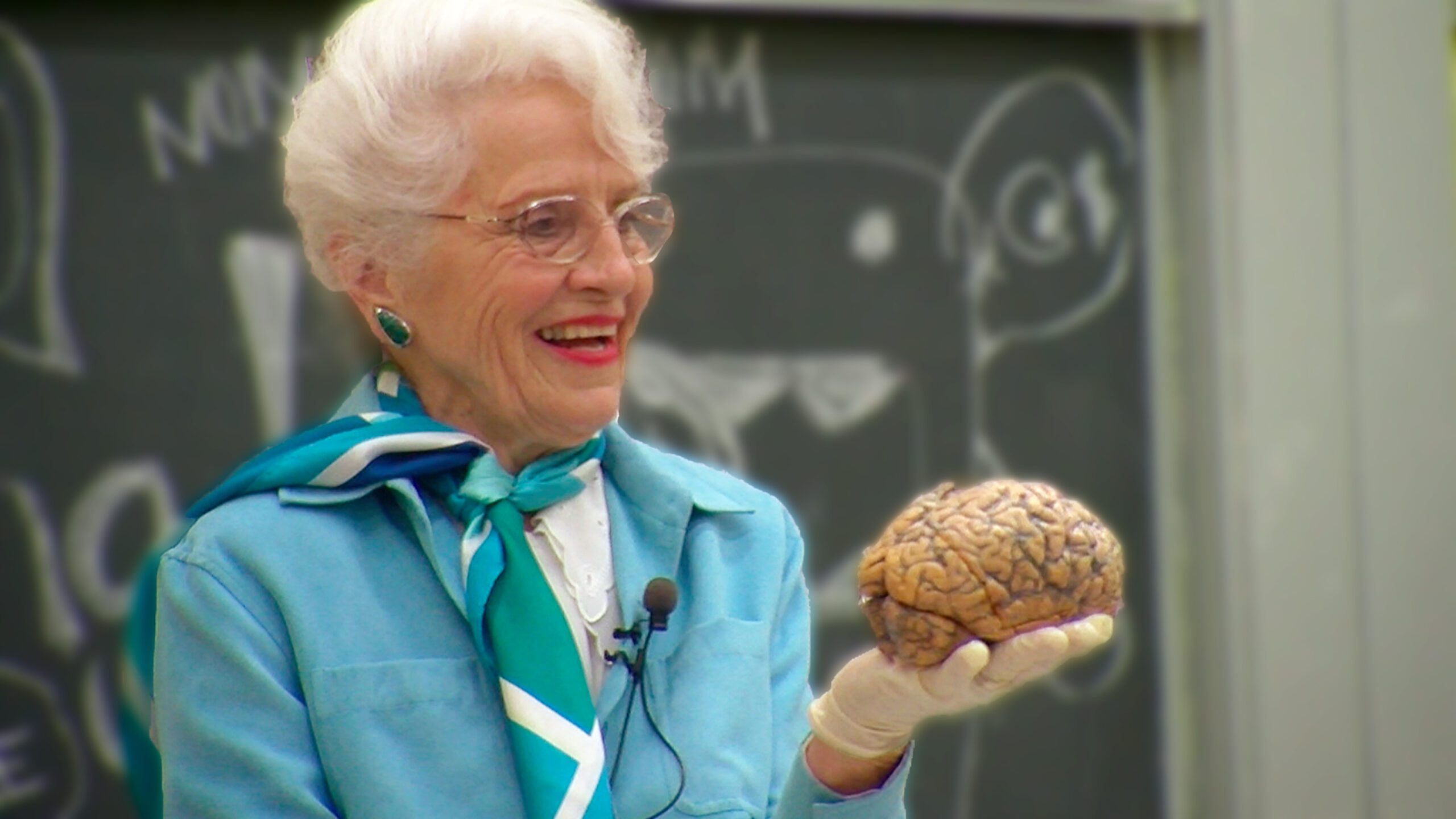
Jesse Cox
Aliquam lorem ante, dapibus in, viverra quis, feugiat a, tellus. Phasellus viverra nulla ut metus varius laoreet. Quisque rutrum. Aenean imperdiet venenatis.
Amber Webb
Maecenas nec odio et ante tincidunt tempus.